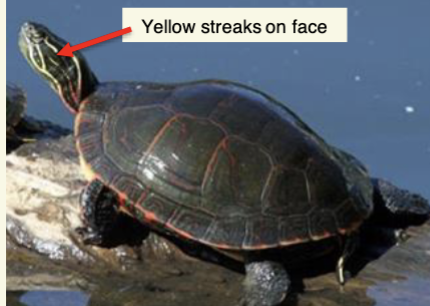Herpetology Practical 2
1/100
Earn XP
Description and Tags
Snakes, Squamata skull evo, Tuataras/Rhynchocephalia, Turtles & Crocs, FoCo Native Species
Name | Mastery | Learn | Test | Matching | Spaced |
|---|
No study sessions yet.
101 Terms
Snakes are in which order?
Order Squamata
Families: 25 total, 7 for us to know
Snake Families
Colubridae
Viperidae
Leptotyphlopidae
Elapidae
Pythonidae
Loxocemidae
Boidae
Snake Distribution & Hotspot
Distribution: Global (except Antartica)
Hotspot: Mexico
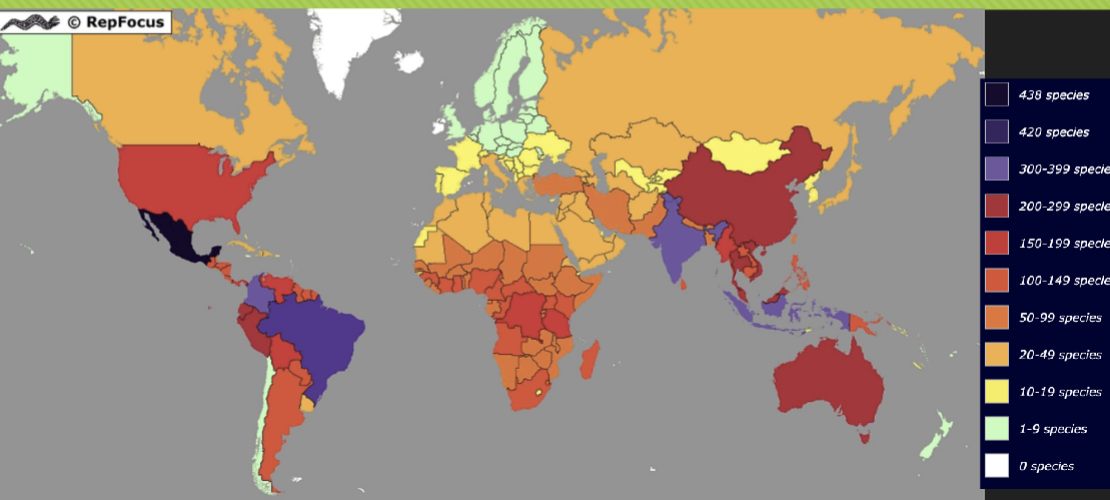
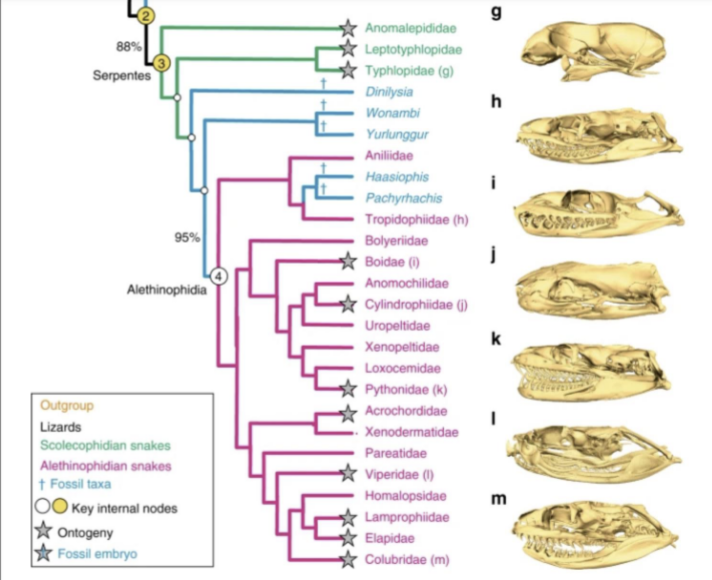
Snake Family Phylogenetic Tree
Families with the most species
Colubridae – 2,055
Elapidae – 389
Viperidae - 341
Families with only one species
Aniliidae
Loxocemidae
Xenotyphlopidae
Body Scale Type
Keeled/Rough or Smooth
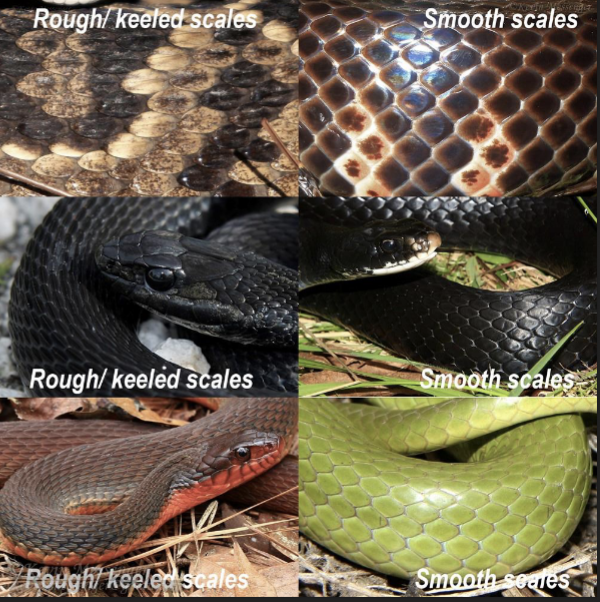
Anal Scale Type
Single or Divided
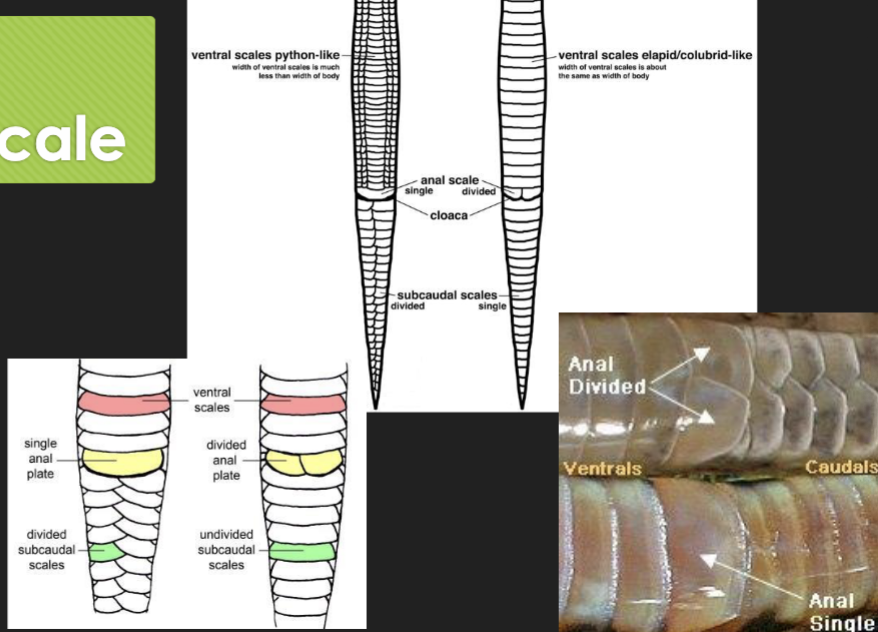
Labial Scales
Barred or Plain
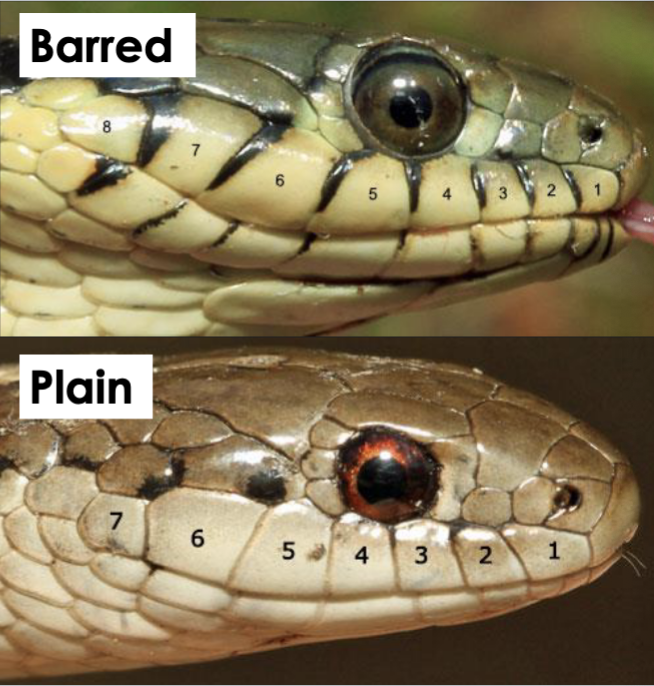
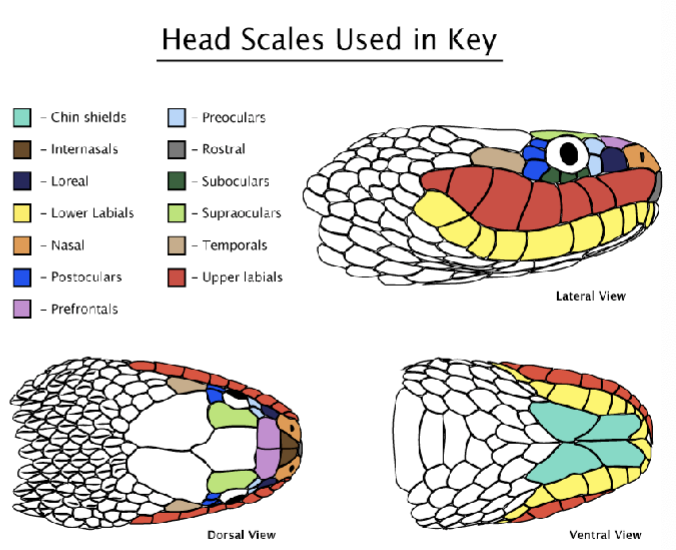
Head Scales
Large plate scales or Many small scales
Supraocular or absentt
Rostral scale
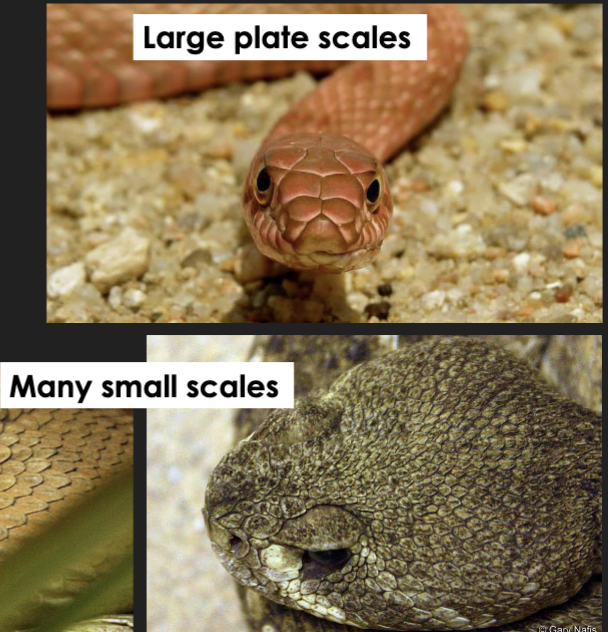
Head Shapes
Angular, Wide, Blunt/round, Flat, Rectangular, Wedge, Large
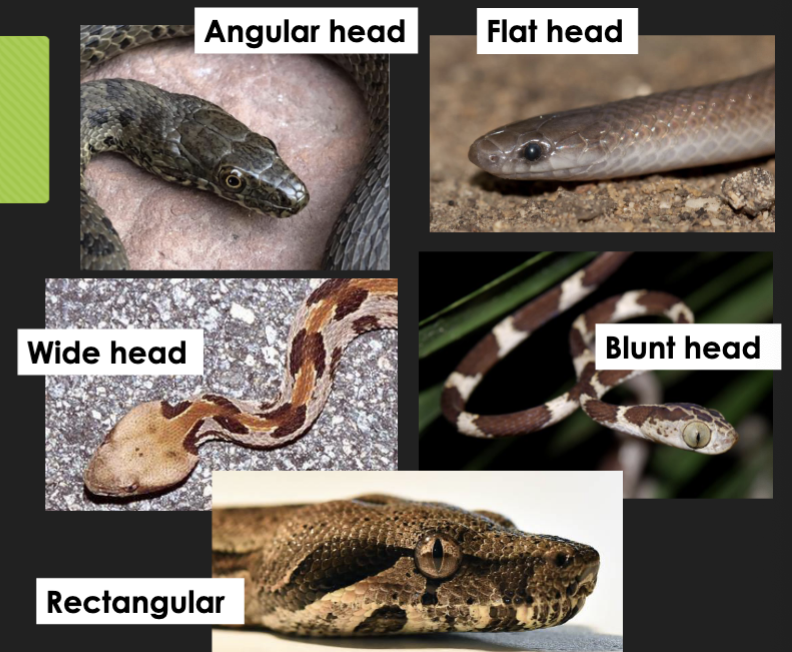
Eye morphology

Body type
body size, tail length, rattle present or not
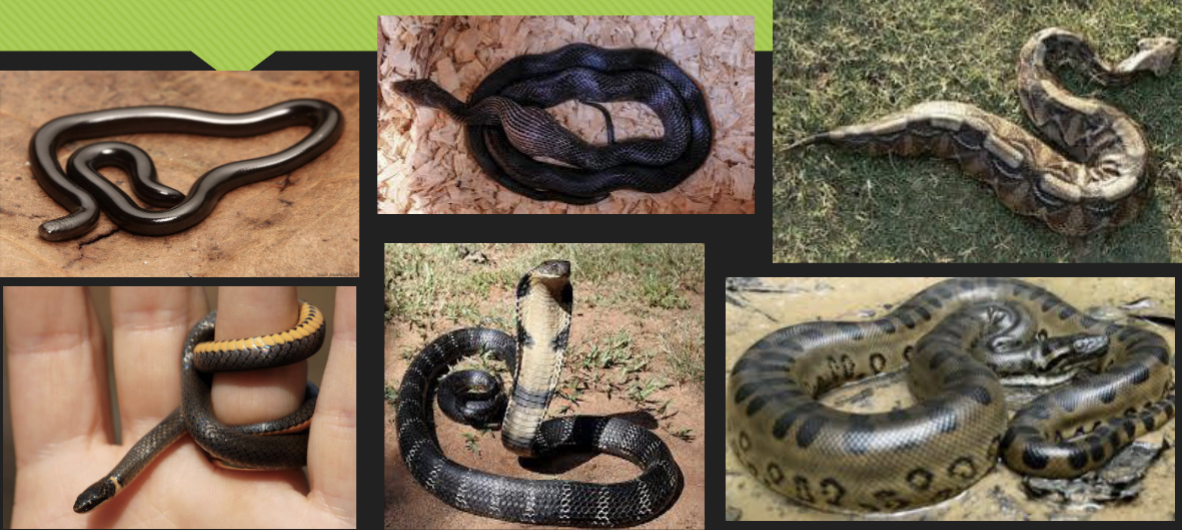
Rattle
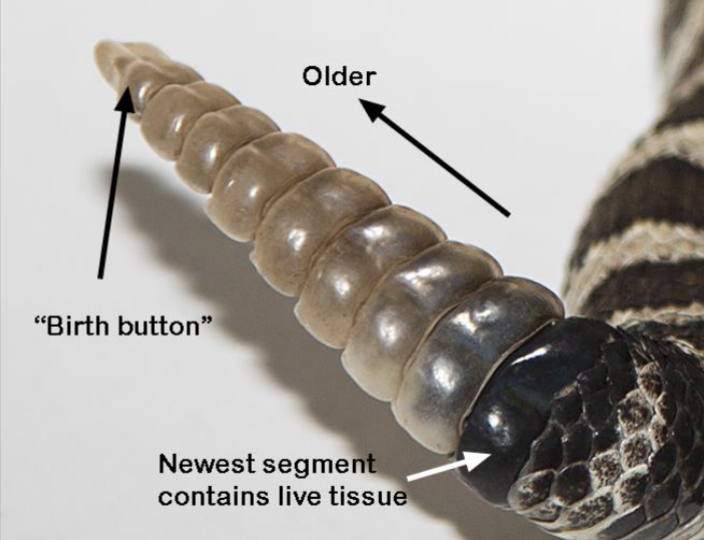
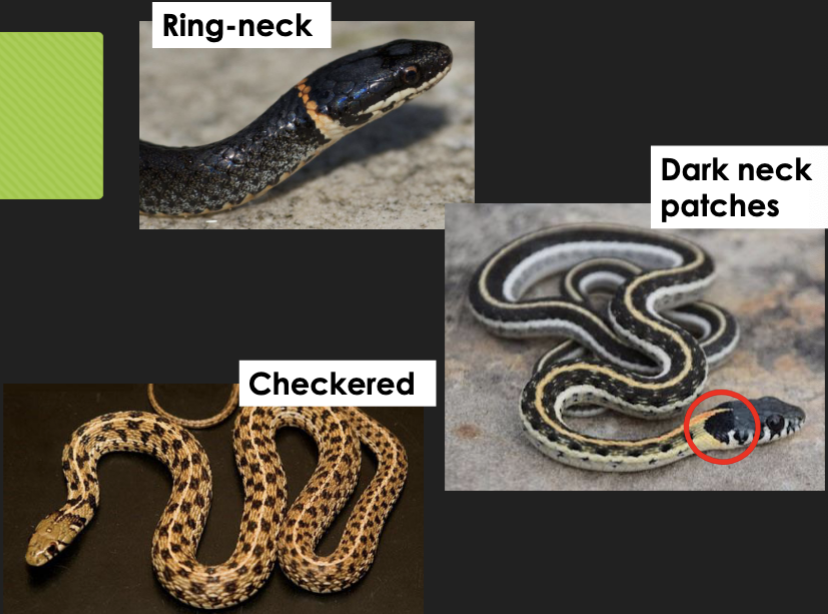
Patterns
Banded, Striped, Saddle, Mask, Ring neck, Dark or Black neck patterns, Checkered
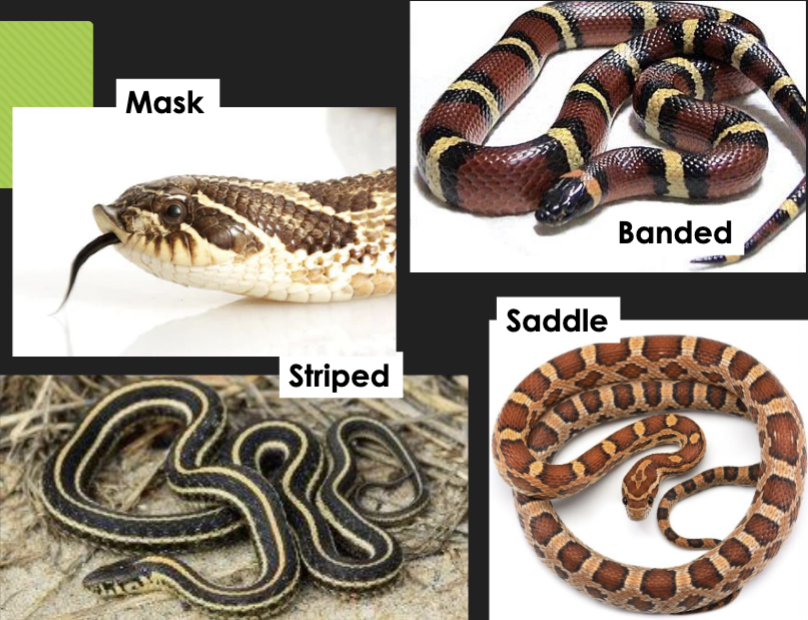
Reproductive Strategy
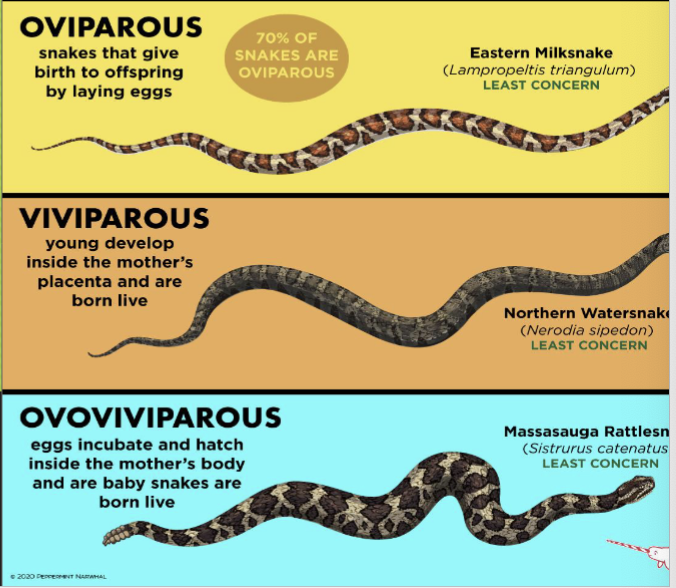
Colorado Families Snakes
Colubridae - most snakes
Leptotyphlopidae - blind snakes
Viperidae - vipers, ratlesnakes
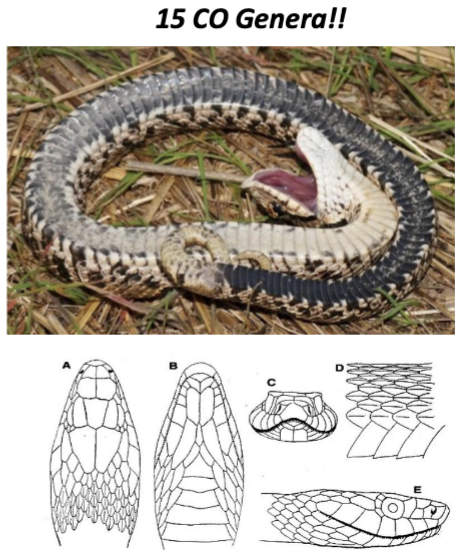
Colubridae - 70% of all snakes
Morphological diverse family
distinct labial scales
large plate head scales
Wide ventral scales
CO Genera
Thamnophis
Lampropeltis
Coluber
Arizona
Diadophis
Heterodon
Hypsiglena
Opheodrys
Nerodia
Pantherophis
Pituophis
Rhinocheilus
Sonora
Tantilla
Tropidoclonion
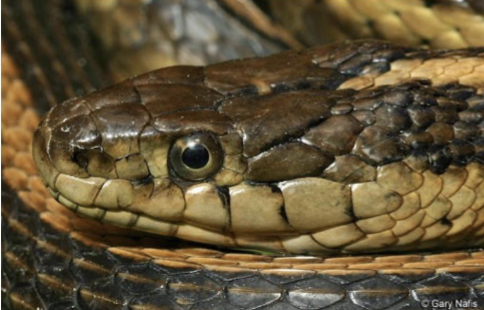
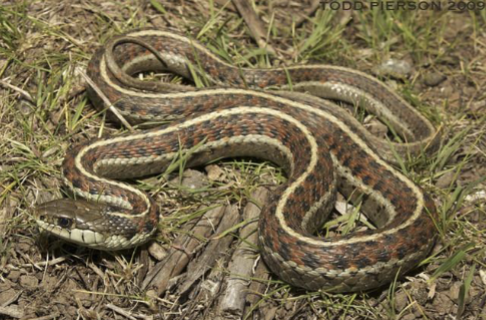
Genus: Thamnophis
CO species (5): T. elegans, T. cyrtopsis, T. sirtalis, T. radix, T. proximus
distinct supraocular scale, large eyes w/ round pupils, large labial scales,
rectangular head, blunt rostrum
usually single anal scale, keeled scales
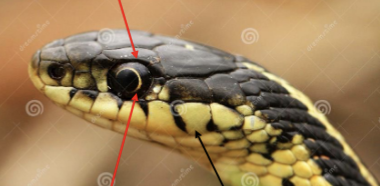
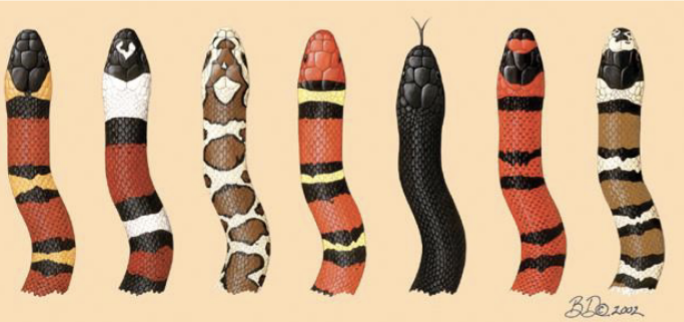
Genus: Lampropeltis
CO species (2): L. getula, L. triangulum
round head, large plate head scales
smooth + glossy scales, banded color pattern
usually single anal scale
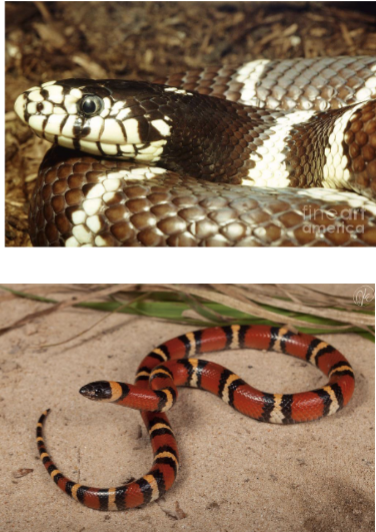
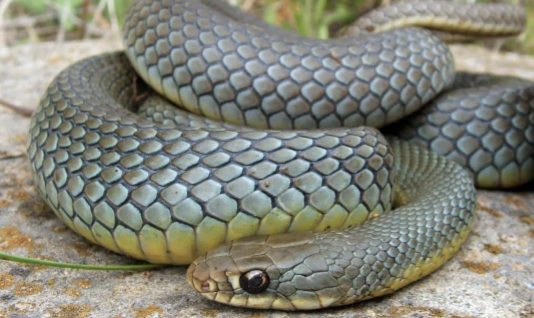
Genus: Coluber
CO species (3): C. constrictor, C. flagellum, C. taeniatus
angular head, distinct supraocular scale, large head plates, long tail and body
anal scale divided
many have smooth scales & some keeled
distinct supraocular, broad labial scales
long braid like tail
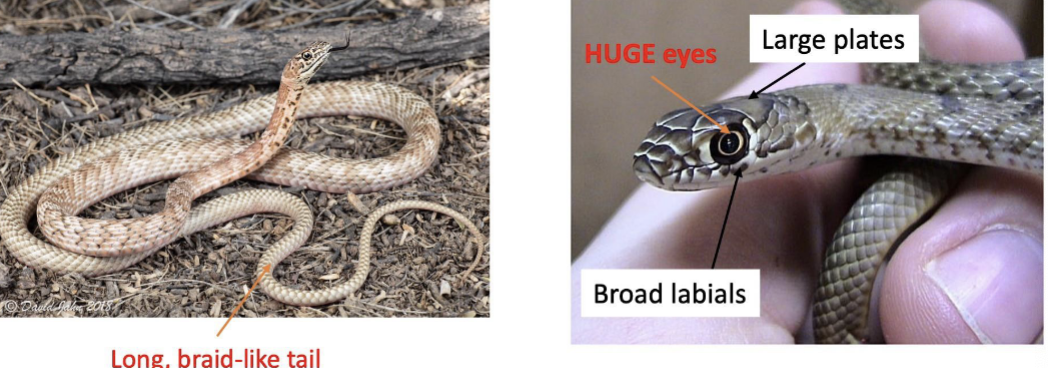
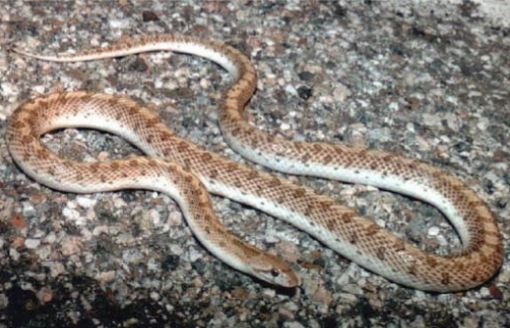
Genus: Arizona
CO species (1): A. elegans
large head plates, mask on face, labial scales
smooth + glossy scales, saddle pattern
single anal scale
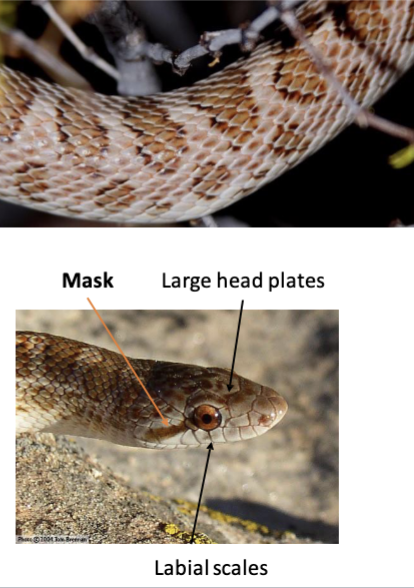
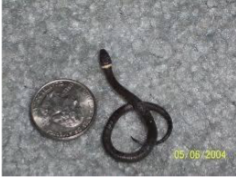
Genus: Diadophis
CO species (1): D. punctatus
flat head, large head scales
ring neck color pattern
small bodies, smooth scales, divided anal scale

Genus: Heterodon
CO species (1): H. nasicus
keeled scales, saddle color pattern
divided anal scale
upturned rostral scale, blunt & wide head, mask on head
will play dead
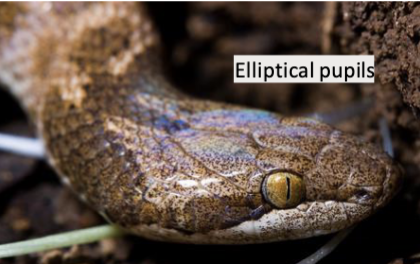
Genus: Hypsiglena
CO species (1): H. torquata
flat & angular head, large head plate scales, elliptical pupils
checkered dorsal pattern, dark neck & nape patch
mask on face, divided anal scale, smooth scales

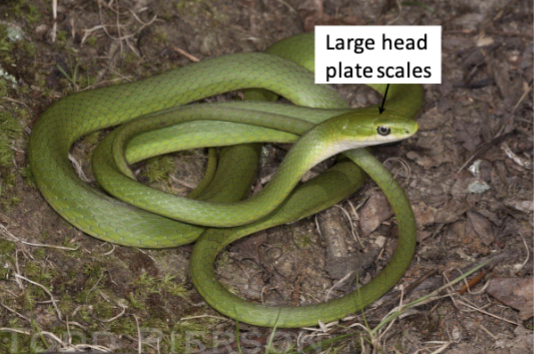
Genus: Opheodrys
CO species (1): O. vernalis
large head plate scales, angular head, distinct supraocular scales
slender body, large eyes, smooth scales, divided anal scale
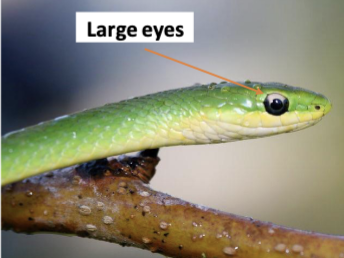
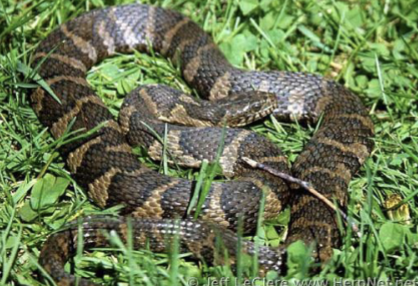
Genus: Nerodia
CO species (1): N. sipedon
Large head, barred labial scales
saddle pattern, rough keeled scales, large-xbodied, divided anal scale
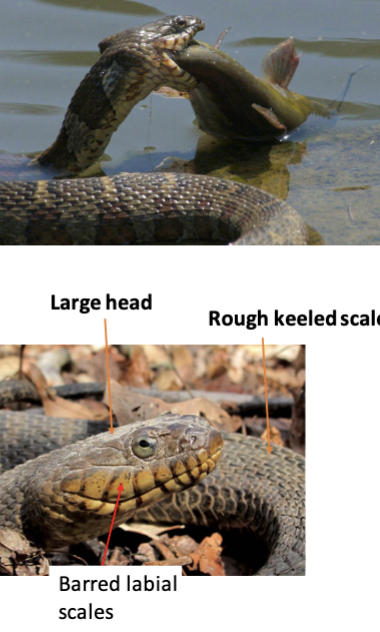
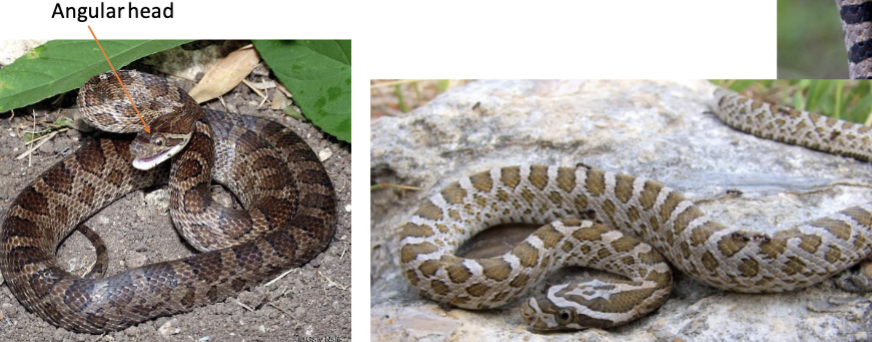
Genus: Pantherophis
CO species (1): P. emoryi
angular head, mask on face, labial scales
saddle color pattern, smooth scales, long body
divided anal scale
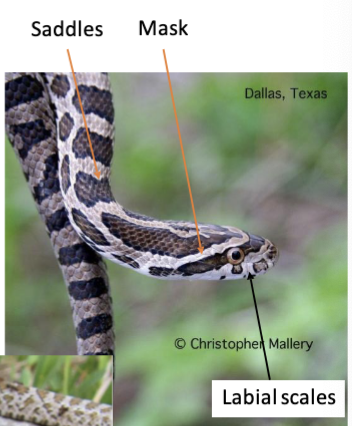
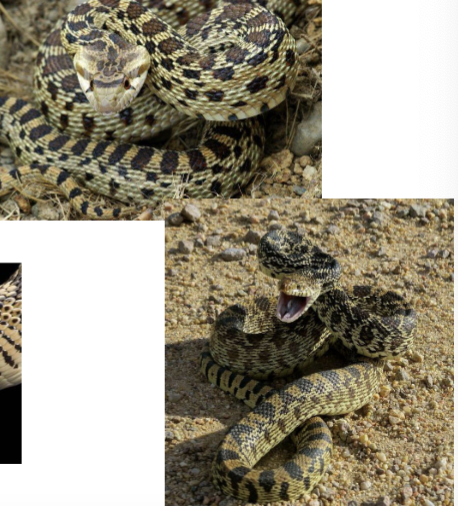
Genus: Pituophis
CO species (1): P. catenifer
Large bodied, saddle color pattern, keeled scales, single anal scale
large head & head plate scales, distinct rostral scale, barred labial scales
can widen head when pretending to be rattlesnake (even shakes its tail)
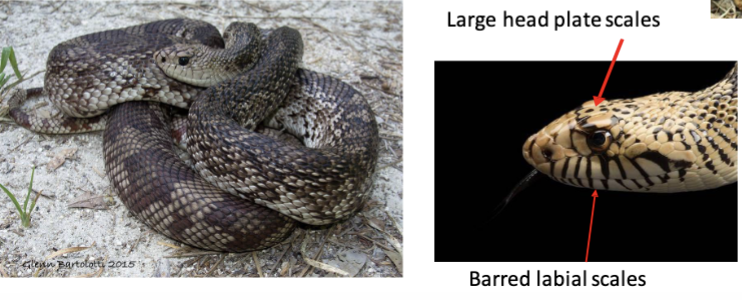
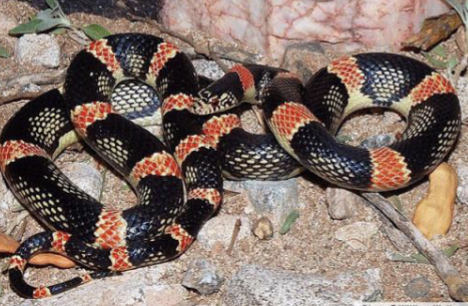
Genus: Rhinocheilus
CO species (1): R. lecontei
angular head, distinct rostral scale, barred labial scales, round pupils
banded color pattern, smooth scales, single anal scales
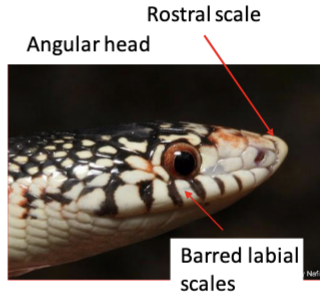
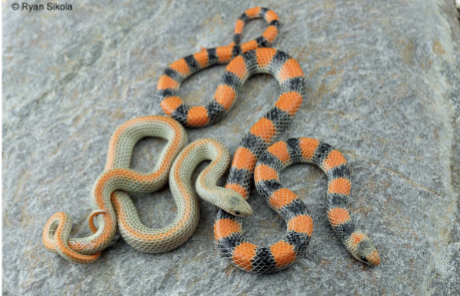
Genus: Sonora
CO species (1): S. semiannulata
blunt & angular head, large-headed plate scales
small body, saddle or banded color pattern, smooth scales, divided anal scale

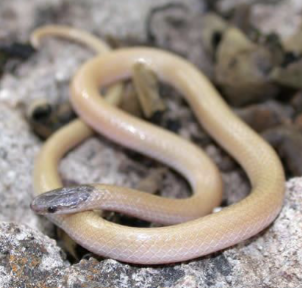
Genus: Tantilla
CO species (2): T. nigriceps, T. hobartsmithi
flat head, rounded rostrum, large head plate scales, black head
smooth scales, small body, light body, divided anal scale, small size
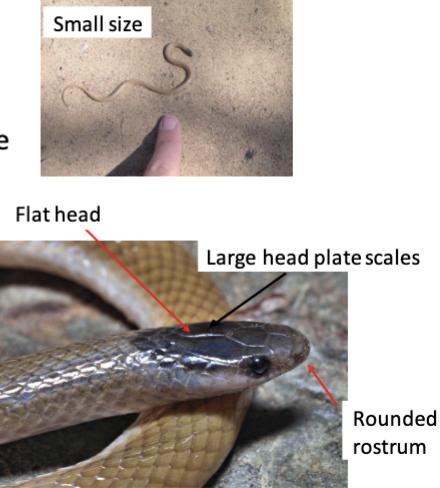
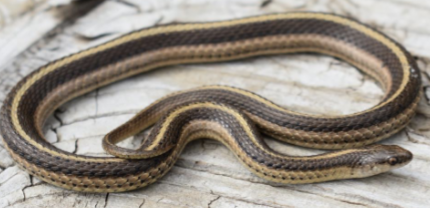
Genus: Tropidoclonion
CO species (1): T. lineatum
keeled scales, small size, single anal scale
blunt/rounded head, 5-6 labial scales
distinct ventral pattern, distinct dorsal stripe
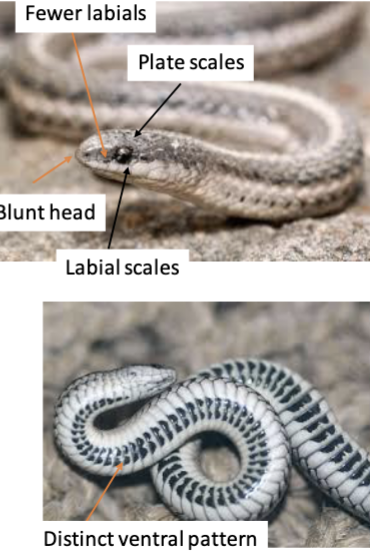
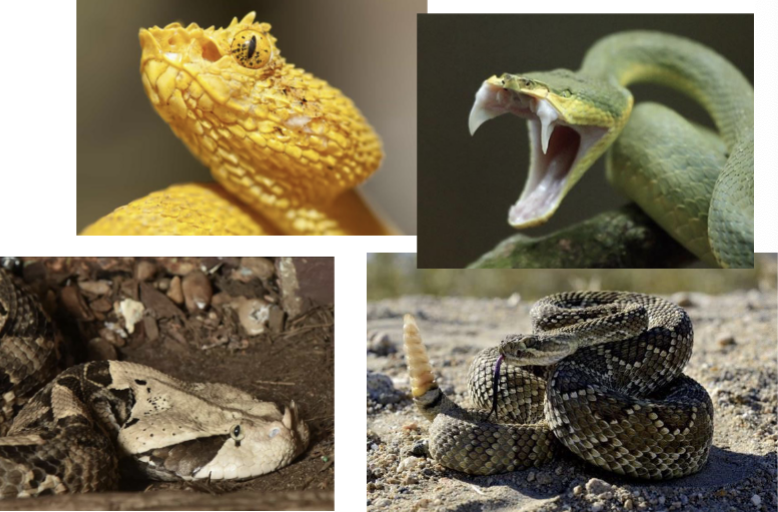
Viperidae - Vipers & Rattlesnakes
Wide head
Many small head scales
Distinct supraocular scale
Keeled scales
Sensory pits
Most elliptical pupils
Rattle
CO Genera
Crotalus
Sisturus
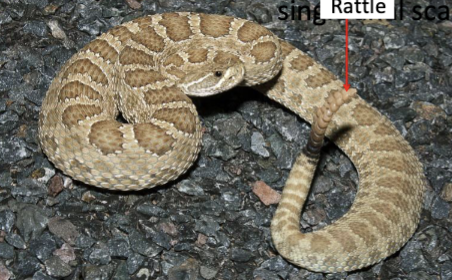
Genus: Crotalus
CO species(2): C. viridis & C. oreganus
short wide body, short tail, large rattle
wide head with many small scales
rough-keeled scales
elliptical pupils, mask on face
saddle color pattern
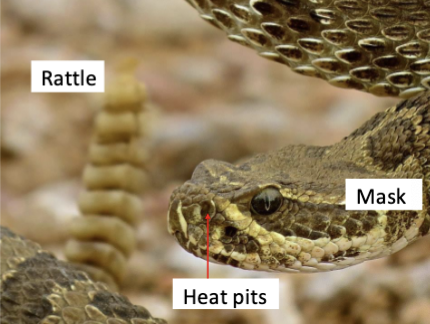
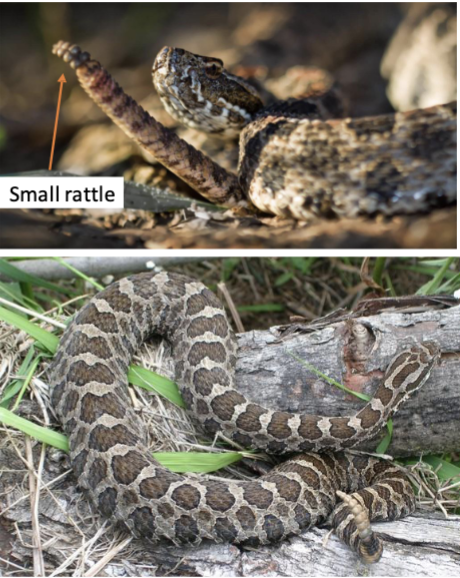
Genus: Sisturus
CO species(1): S. catenatus
small body, small rattle, short tail
large plate head scales, wide head, distinct mask
rough keeled scales
saddle color pattern
divided anal scale
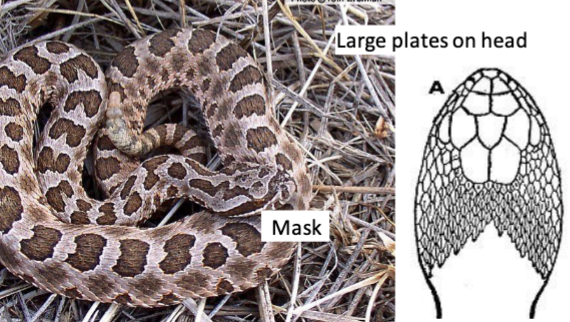
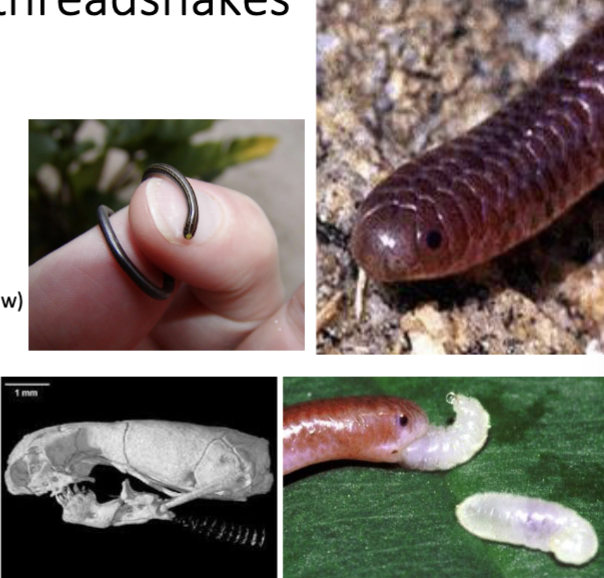
Leptotyphlopidae - Thread snakes
tiny snakes, vestigular eyes
small rounded, blunt head
mandibular (jaw) is inset (overbite)
CO Genera
Leptotyphlops
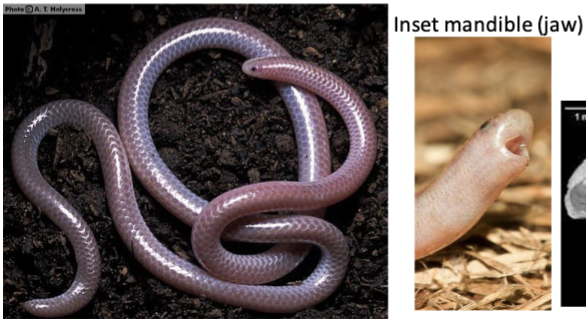

Genus: Leptotyphlops
CO species (1): L. dulcis
smooth shiny scales, small body size (length 10-30cm)
vestigial eyes, inset lower jaw, round blunt head, no teeth on upper jaw
some large head plates
single anal scale
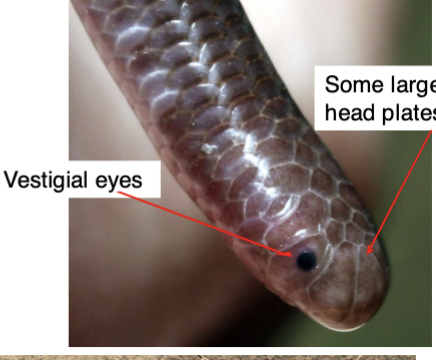
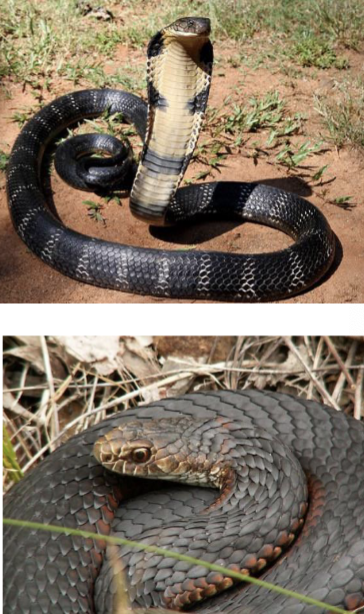
Elapidae - Cobras, Adders, Mambas, etc.
Venomous, fixed hollow fangs
angular head, large labial scales
most have smooth scales
most have slender bodies, wide range of sizes
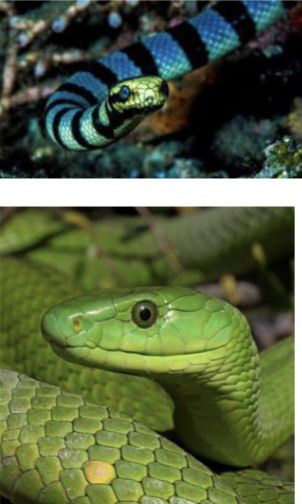
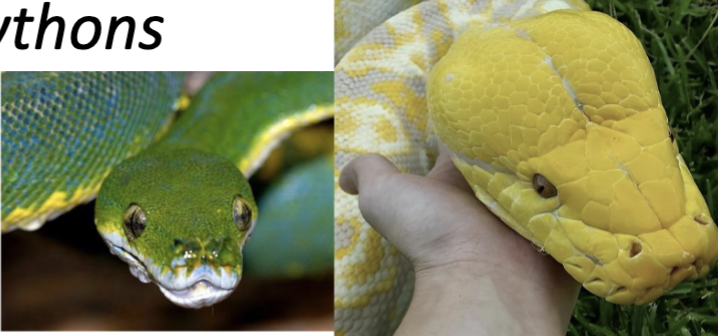
Pythonidae - Pythons
have premaxilla, rectangular head & snout, distinct labial scales (often with pits)
large-bodied, smooth scales, many large plate scales b/w eyes
vestigial limbs


Loxocemidae - Mexican burrowing snake
1 species in this family
shovel-shaped snout, angular head, small eyes
iridescent small smooth scales on body
large head plate scales
pelvic spurs (vestigial limbs)
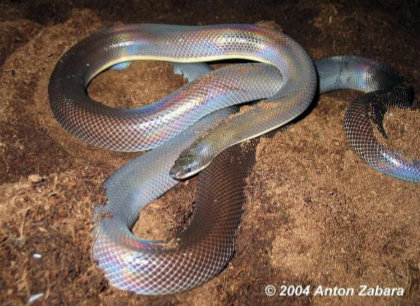
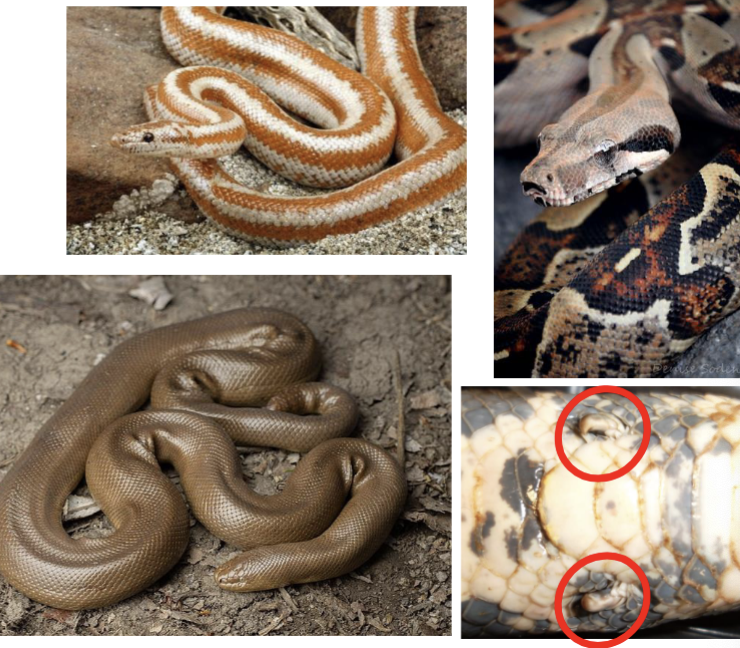
Boidae - Boas
many have rectangular head, others rounded blunt heads
many small scales b/w eyes
wide bodies, short tails, smooth scales, vestigial limbs (pelvic spurs)
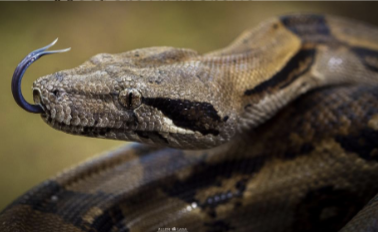
Turtle Phylogeny
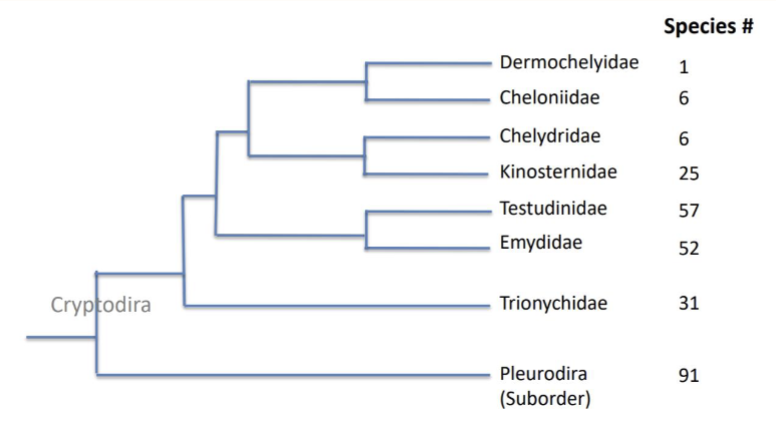
Turtle Distribution & Hotspots
Distribution: Equatorial
Hotspots: New Guinea, Amazon, Congo
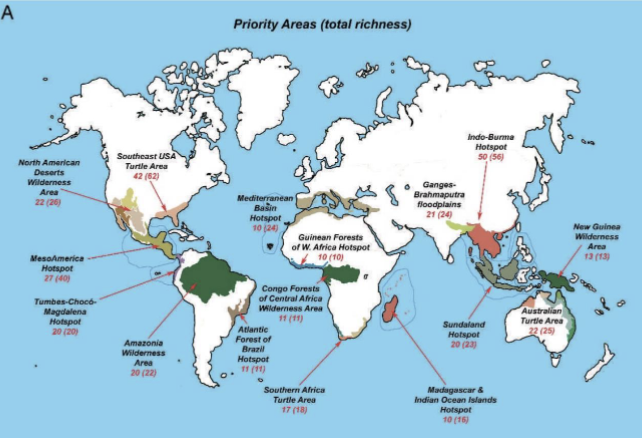
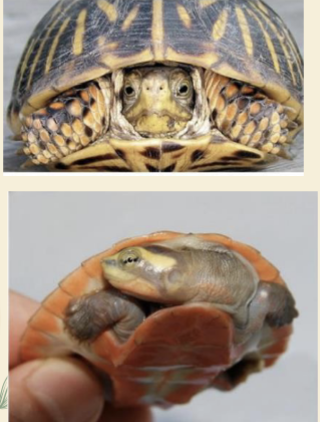
Turtle Head retraction
Cryptodira: striaght
Pleurodira: sideways
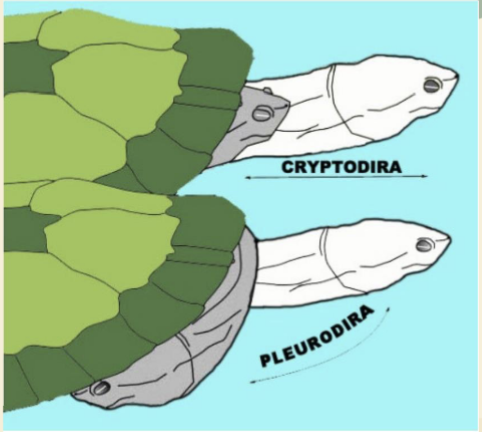
Tubercles
Spikes on the dorsal aspect of the neck
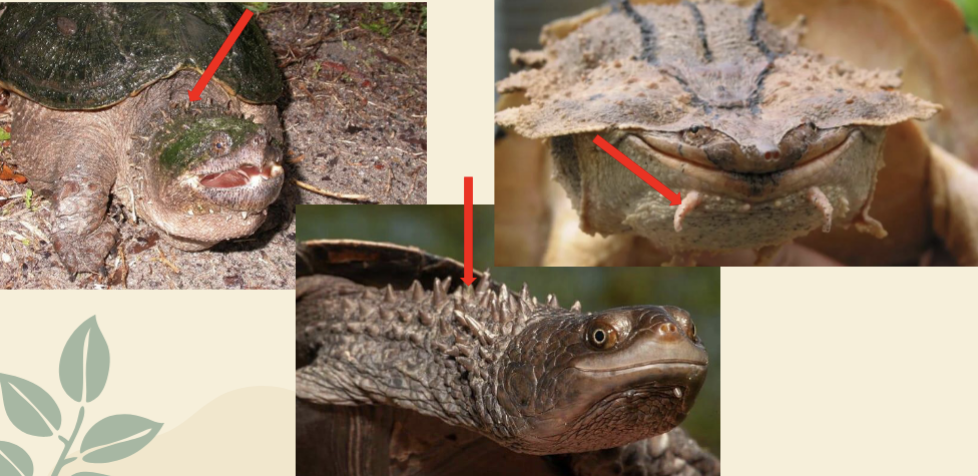
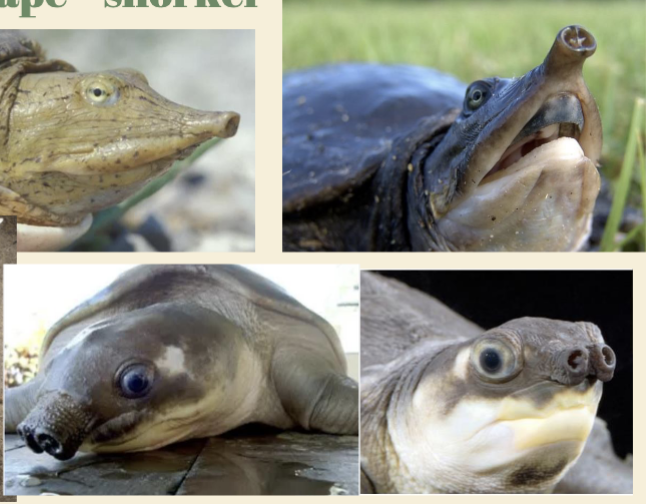
Nose shapes
snorkel, beak, or normal
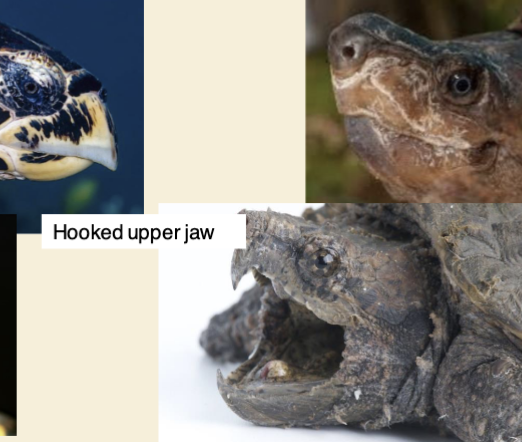
Head size
large vs small
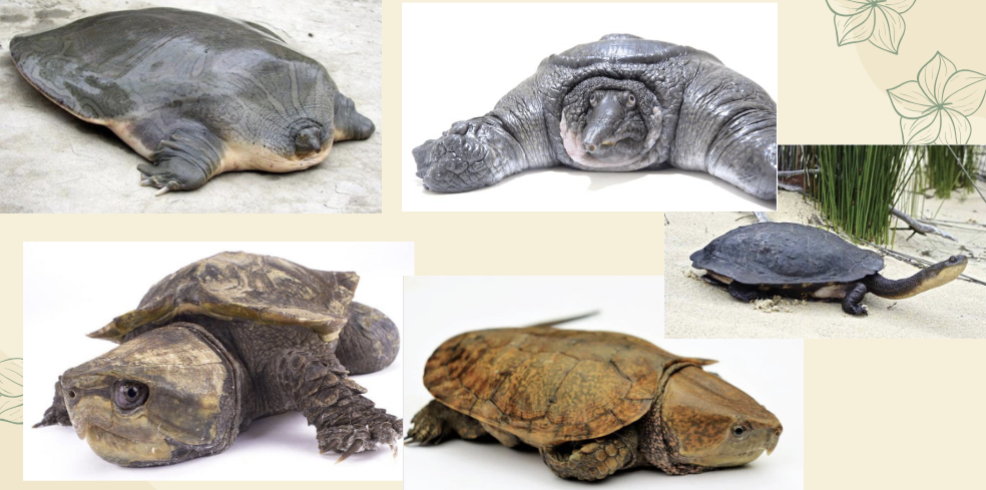
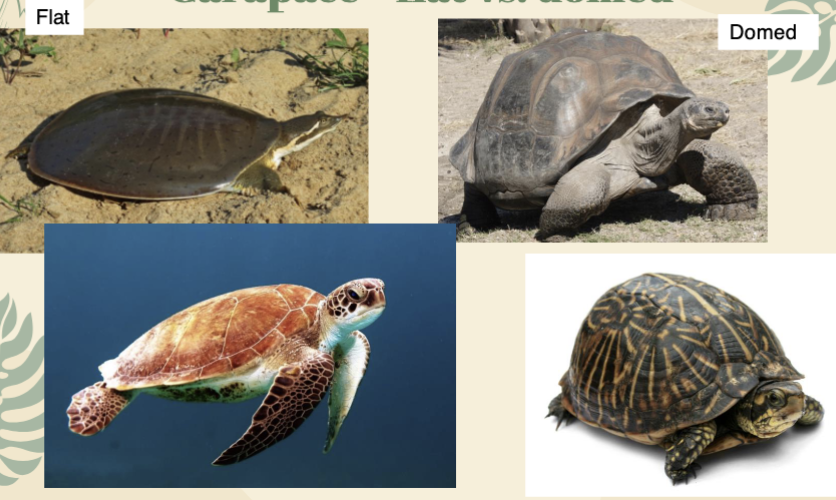
Carapace
Flat vs Domed
Smooth vs Ridged
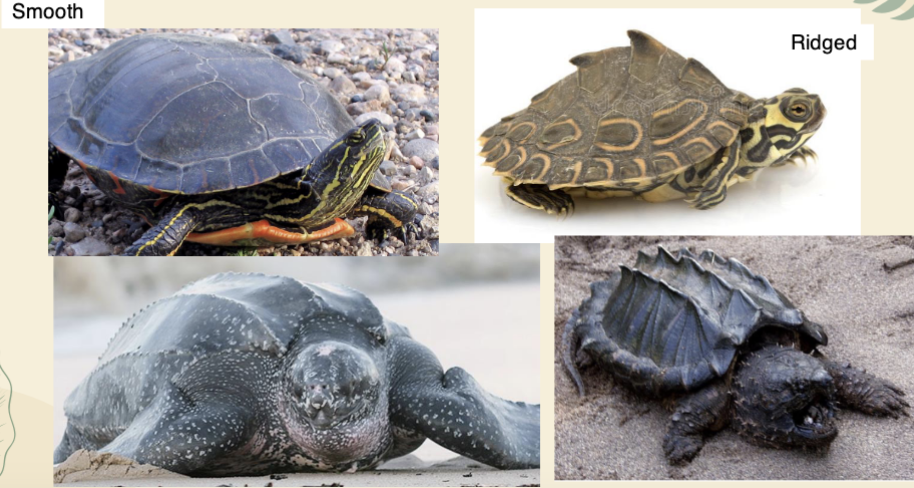
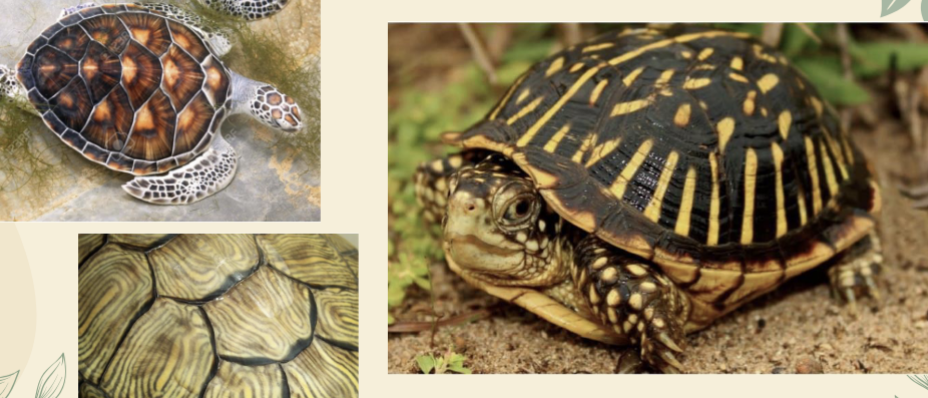
Scute & Plastron
Scute: Patterns on carapce
Plastron: Shape and pattern (ventral)
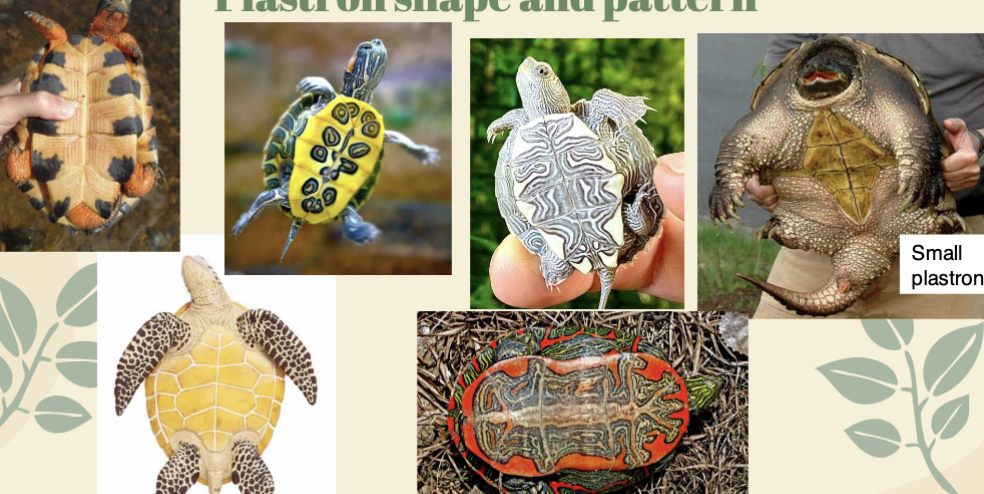
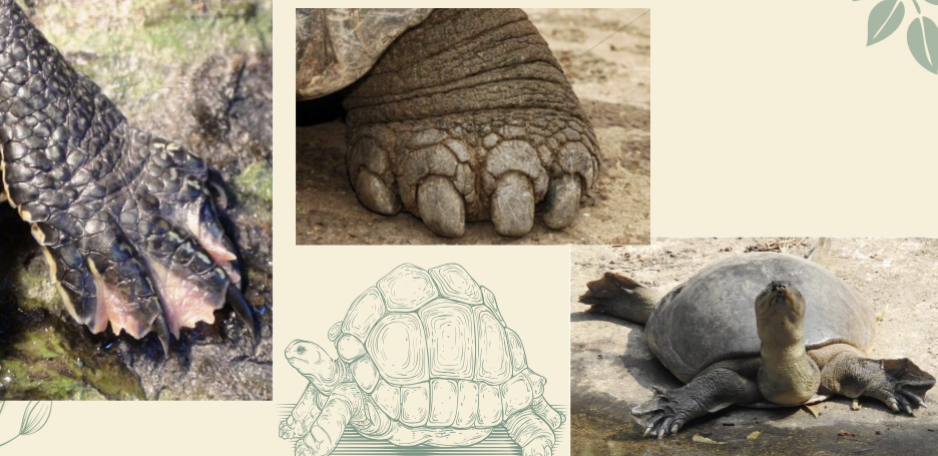
Feet
Degree of webbing/claw shape or Paddles
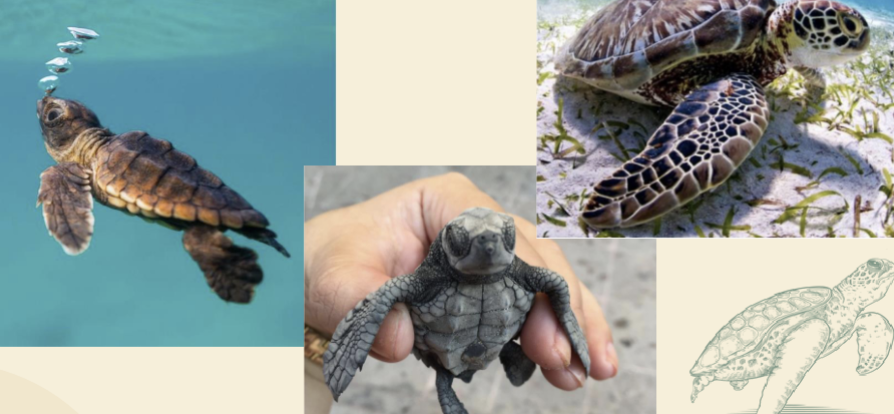
Tail
size and shape
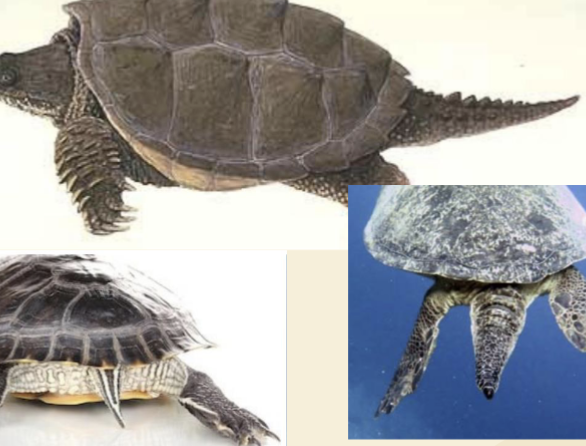
Colorado Turtle Families
Chelydridae - Snapping turtles
Emydidae - Box & Pond turtles
Kinosternidae - Mud & Musk turtles
Trionychidae - Softshell turtles
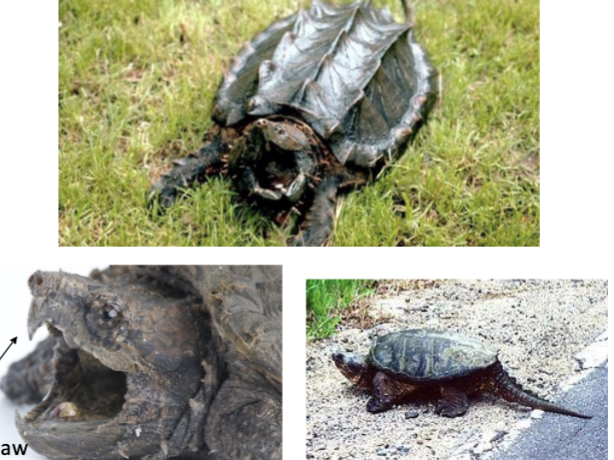
Chelydridae - Snapping Turtles
Large heads and limbs that can’t retract into shell
hooked upper jaw
long tails
tubercles on head & neck
ridged carapace; small plastron
CO Genera:
Chelydra
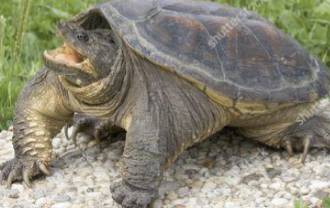

Emydidae - Box & Pond Turtles
Smooth shells
large carapace & plastron compared to body
webbed feet
uniquely patterned plastrons
able to retract head & limbs straight into shell (Cryptodira)
CO Genera:
Chrysemys
Terrapene
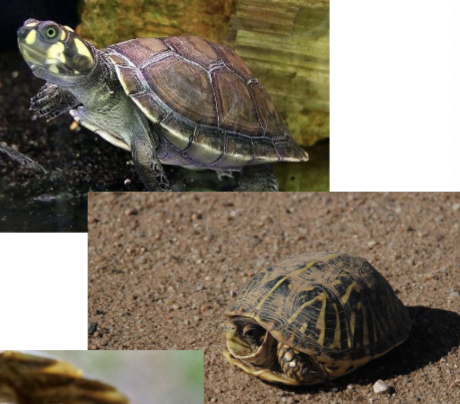
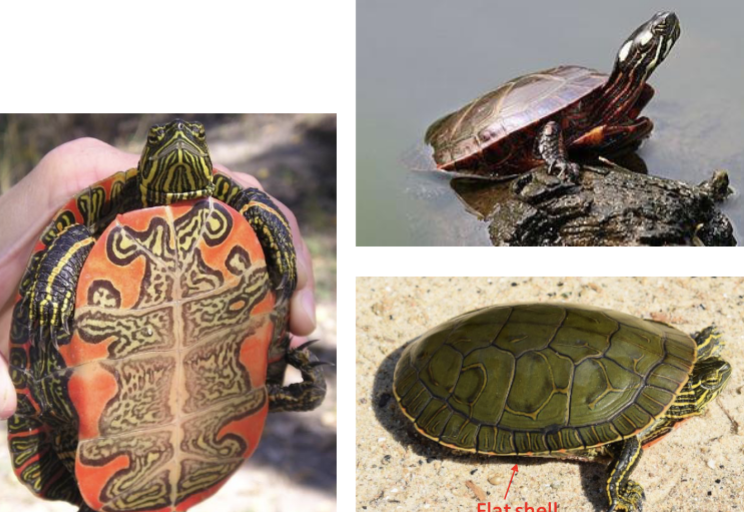
Genus: Chrysemys
CO species (1): C. picta
smooth, brightly colored shell
shell is relatively flat
striped pattern on head
colorful plastron
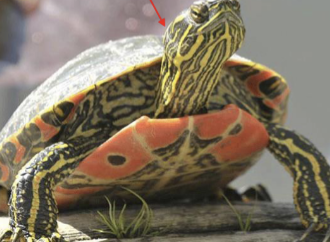

Genus: Terrapene (box turtle)
CO species (1): T. ornata
high rounded upper shell
hinged plastron
patterned scutes
more terrestrial, lacks webbing on feet
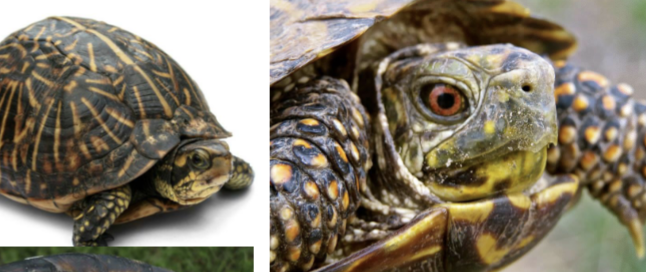

Kinosternidae - Mud & Musk turtles
generally small turtles
highly domed, oval-shaped carapace
most have a plain shell w/ no pattern
big head, pointed snoutx
CO Genus: Kinosternon
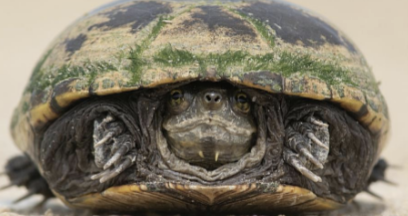
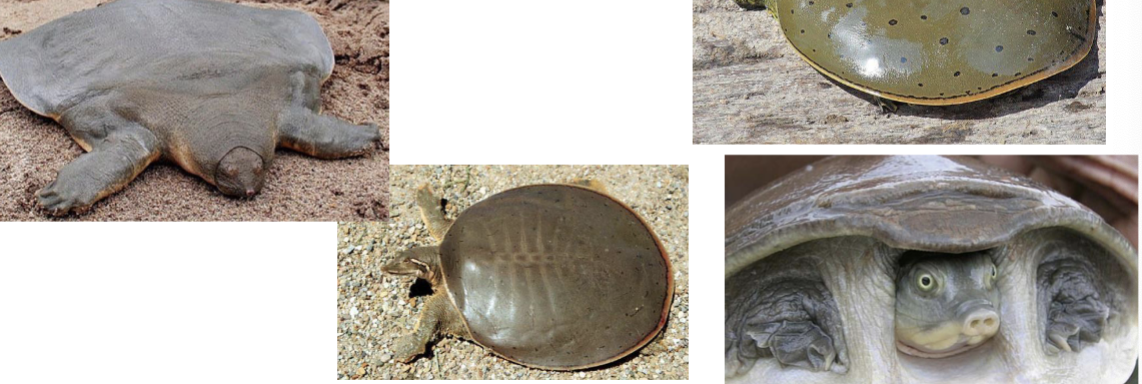
Trionychidae - Soft chell tutles
Flattened bodies
smooth, letheratherly, soft shells
snorkel noses
extensive feet webbing
CO Genus: Apalone
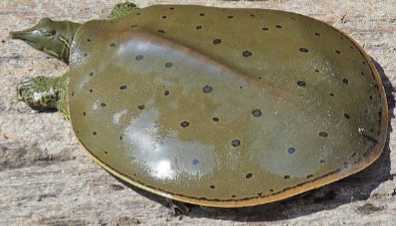

Dermochelyidae - Leatherback turtles
largest of all turtle families
leathery carapace embedded w/ osteoderms
cannot fully retract head
limbs modified into flippers
weal jaw - only prey on jellyfish
only one extant species in this family
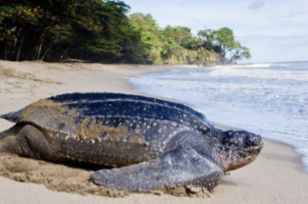
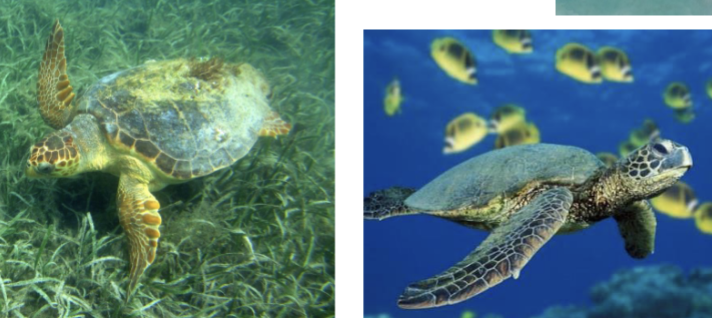
Cheloniidae - Sea turtles
only turtles whose front limbs are stronger than back limbs
large turtles
oval or heat shaped carapace
limbs modified into flippers
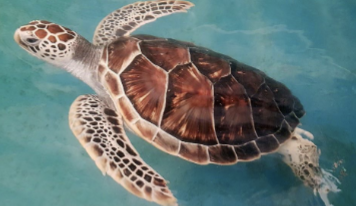

Testudinidae - Tortoises
Largest of the land turtles
Domed carapace
Most have no hinge on plastron
Thick legs
Webless feet with short toes
Very small brains
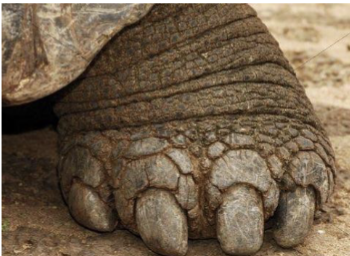
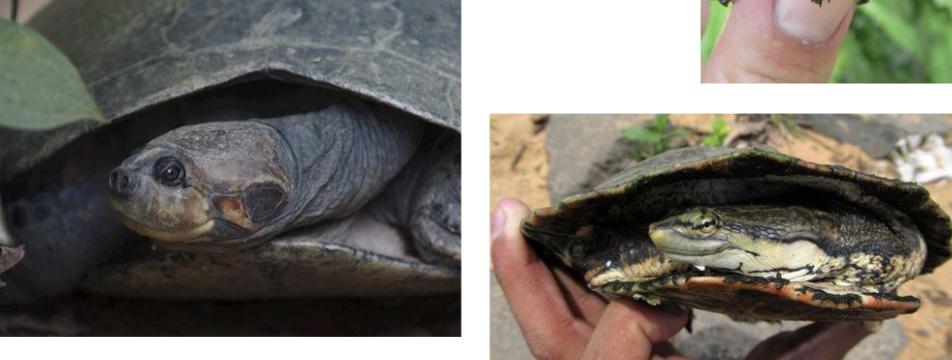
Pleurodira (suborder) - Side-Necked turtles
retract necks sideways into shell (Pleurodira)
large overhang of carapace
12 scutes on plastron
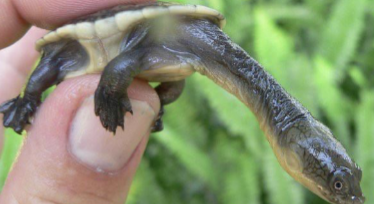
Crocodilian phylogeny
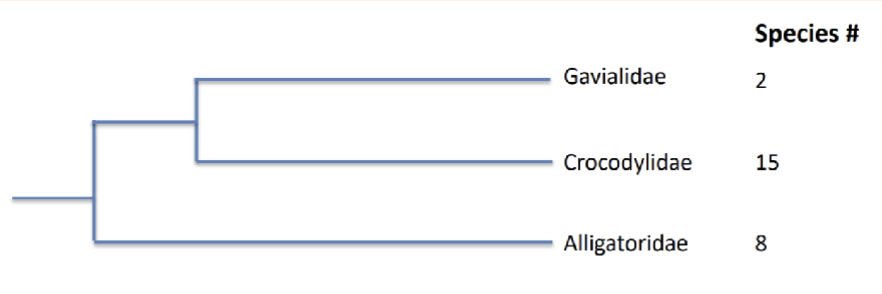
Crocodile Distribution and Hotspot
Distribution: Global
Hotspot: South America
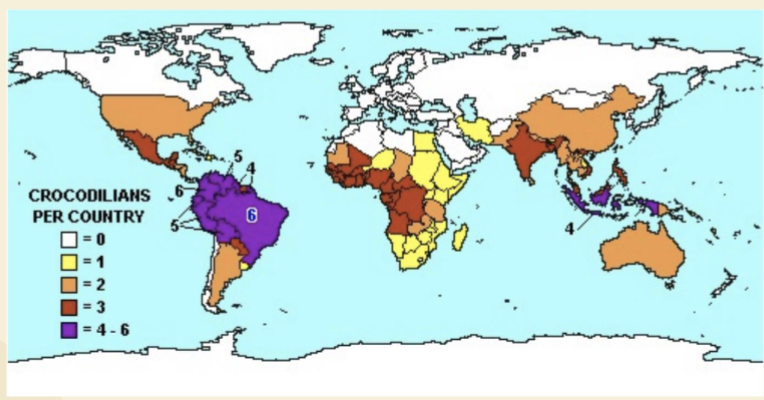
Snout shape & Teeth
Alligator: broader snout, U shape & upper jaw teeth exposed
Crocodile: V shape snout, both mandibular and upper jaw teeth exposed
Gavialidae: slender long snout & needle-like teeth
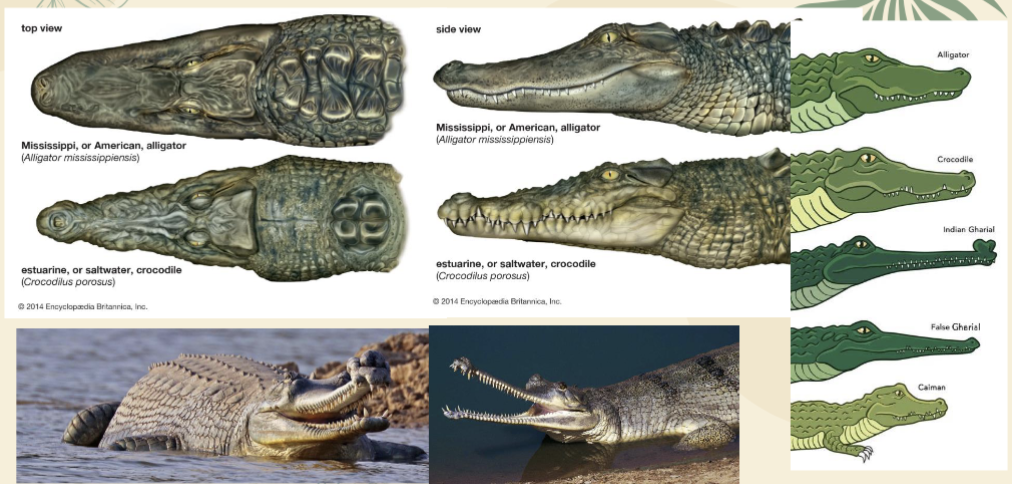
Size
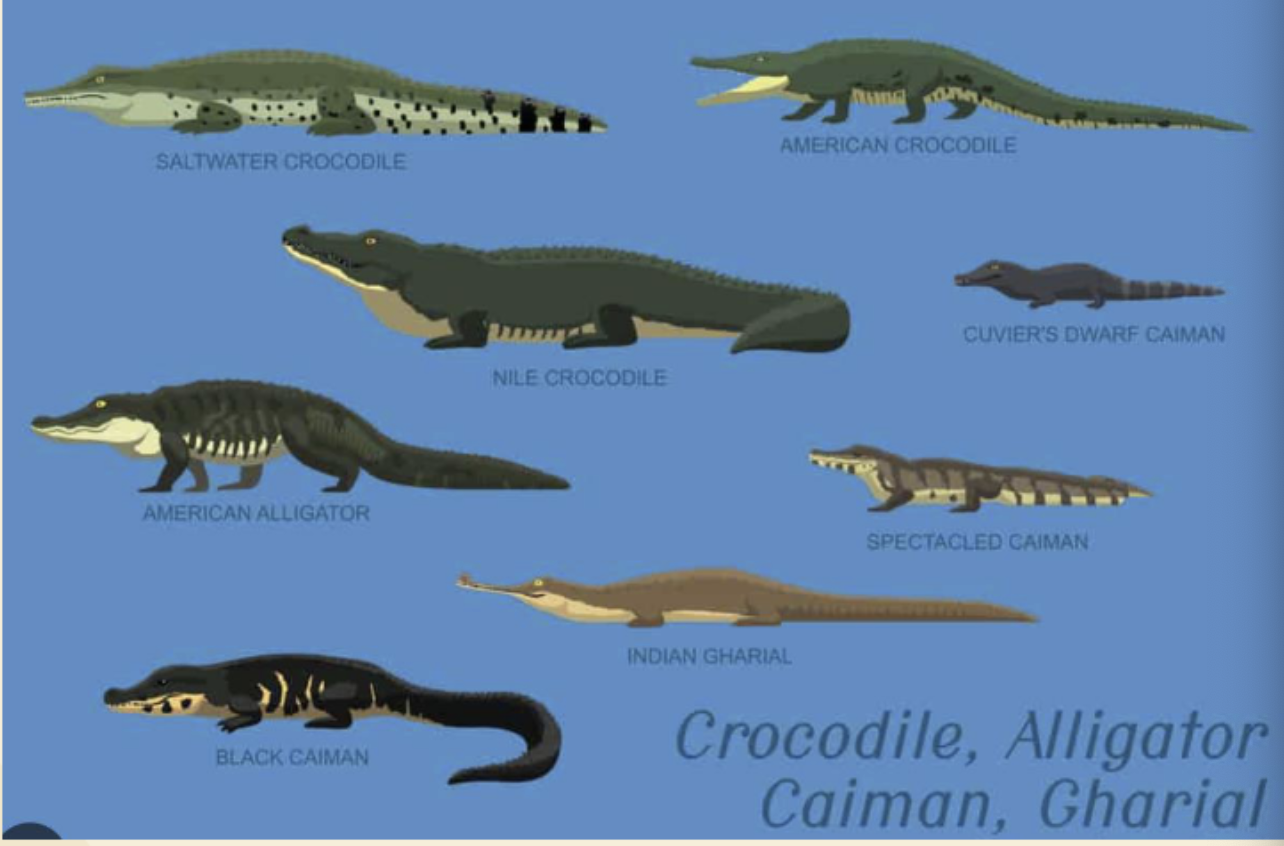
Feet
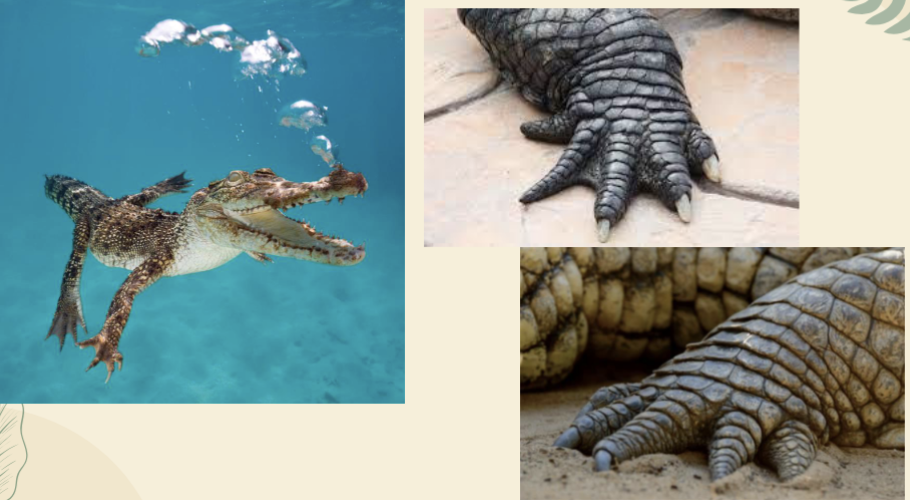
Color
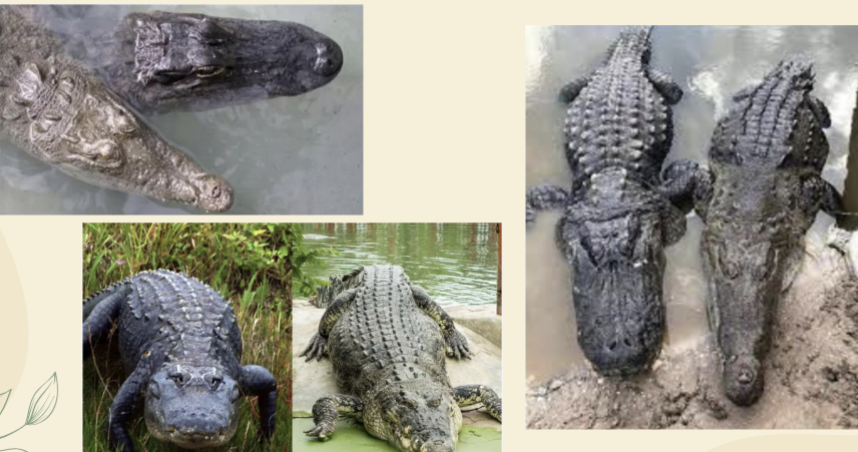
Crocodilian overall traits
Scutes
non-overlapping
keratinous scales formed from dermis
shed individually
osteoderms underneath scutes
laterally compressed (keeled) tail
families can be distinguished by snout shape & teeth

Alligatoridae
4 genera, 8 species
Range: Central & South America also Eastern China
All mandibular teeth fit in upper jaw when mouth is closed
Broader snout (compared to crocodiles)
Caimans
in the subfamily called Caimaninae
Range: Mexico, Central & South America
Relatively small crocodilians
adult size typically ~1.5-2 metes

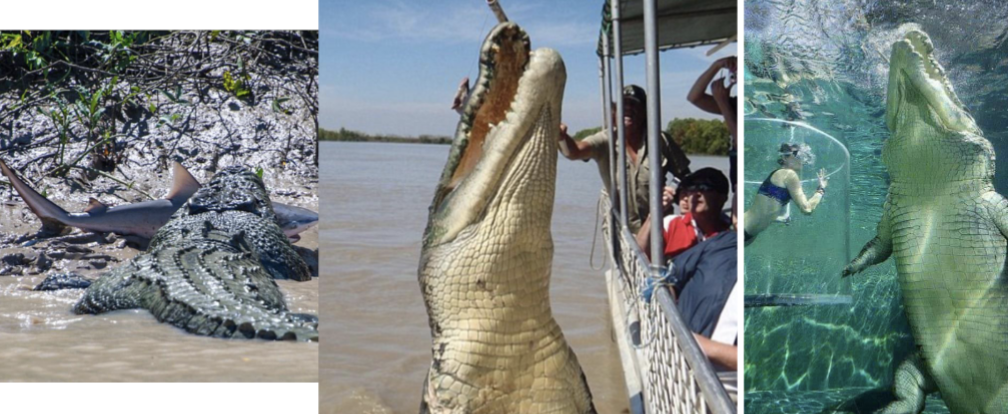
Crocodylidae
2 genera, 13 species
Broadly distributed
Mandibular teeth exposed outside of upper jaw when mouth is closed
Narrower snout (compared to alligators)
Have salt glands that allow them to live in salty habitats
Range in size from 2-7 meters
Crocodylus porosus (saltwater croc) & Crocodylus niloticus (Nile croc) are the largest
Gavialidae
2 monotypic genera
Range: Margins of India & SE Asia
Long, slender snouts
Needle-like teeth
Used to snag fish w/ a side a swipe of the mouth
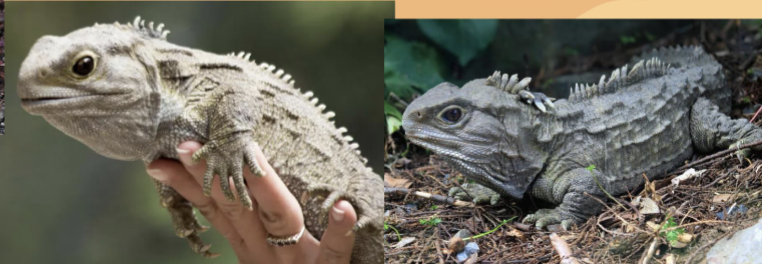
Order: Rhynchocephalia - Tuataras
Only 2 species that are endemic to New Zealand, live on surrounding offshore islands
Sphenodon punctatus
Sphenodon guntheri
“Tuatara” is a Maori word meaning “peaks on back”
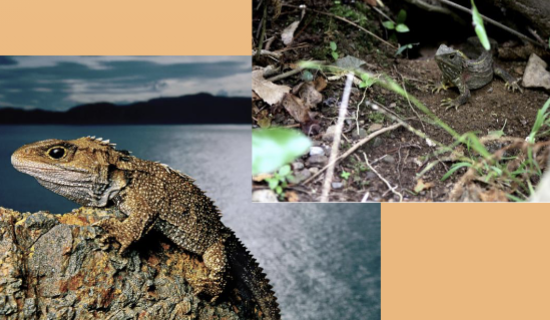
Rhychocephalia Distribution & Hotspot
Tuataras are a separate order from squamates, all other relatives are extinct.
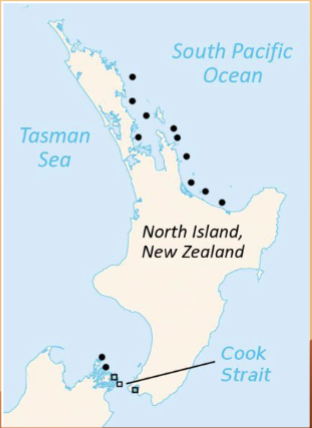
Tuatara Traits
Heavily fringed back
Fringes made from soft, triangular folds of skin
Pronounced photoreceptive third eye
No visible ear
Distinct Jaw - 2 rows of teeth on upper jaw
Rudimentary paired out-pocketing sex organ
Diapsid, like lizards
Nocturnal as adults
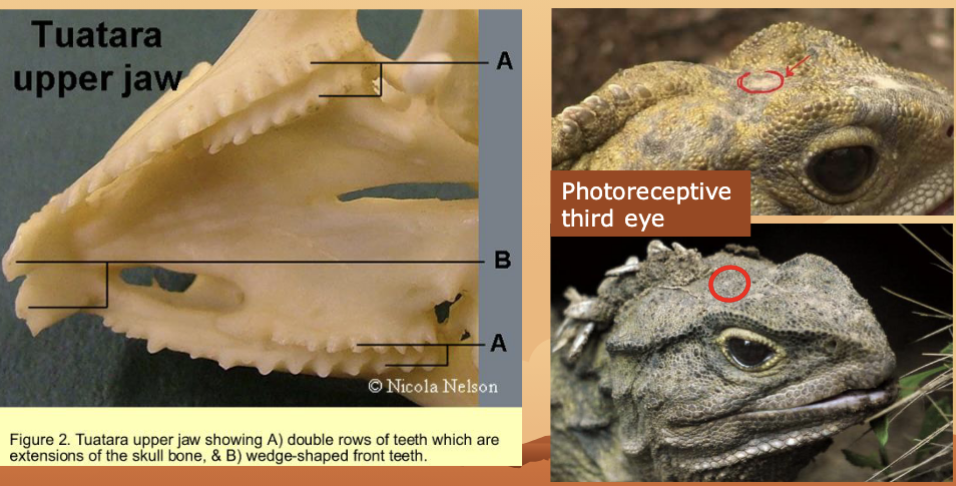
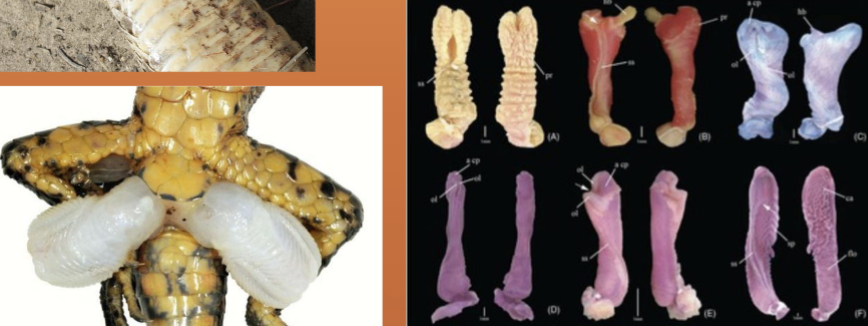
Hemipenes
Squamates (snakes & lizards) have hemipenes
There are 2 (hemi-) for doubling the chance of reproduction
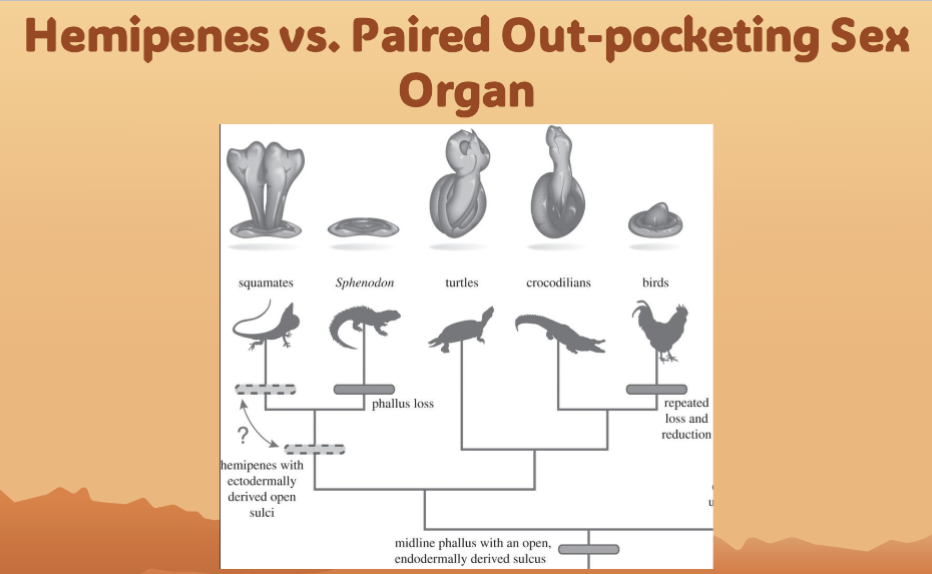
Rhynchocephalia & Squamata Evolution
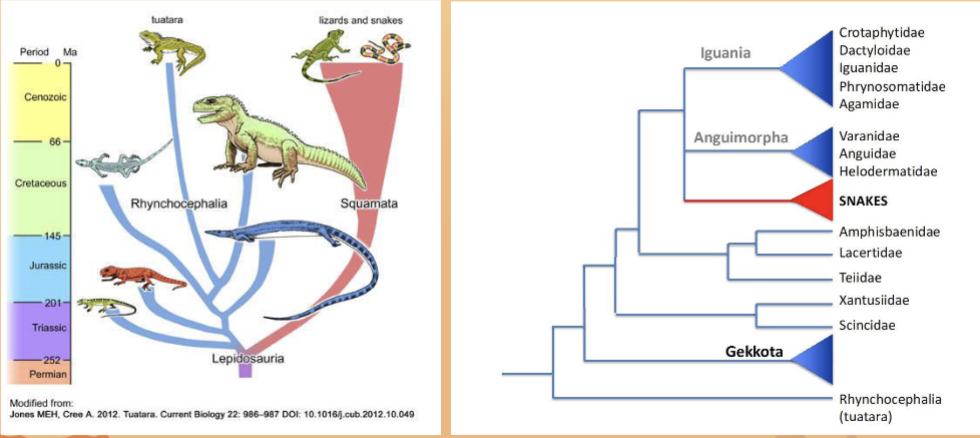
Skull identification
two rows of teeth on upper jaw
maxilla attached to premaxilla
dentary ends in a bifurcate structure
quadrate is thick and positioned further back
supratemporal articulates with the quadrate but has limited motion
What bones make up squamate skull?
Maxilla, Dentary, Quadrate, Supratemporal
Squamate evolution: Snakes
maxilla: has the ability to expand in order to allow them to eat in a more fluid and flexible manner
dentary: their dentary is smaller in size and unfused, making it so that it can widen and allow them to eat prey this much larger than them
quadrate: the dramatic angle of it ensures that he back jaw can widen quite a bit to allow for the successful consumption of large prey
supratemporal: it is more forward so that other skull bones can move with impacting the brain
Squamate evolution: Lizards
maxilla: meant to keep everything steady which accounts for its heftiness and sturdiness
dentary: its structure coincides with the maxilla, allowing them to chew food in a more uniform manner
quadrate: the angle of this structure makes it so that he mouth can only move in a particular direction and accounts for why they are not able to ‘unhinge‘ their jaw to take in prey that is much larger than them
supratemporal: it is placed further back which leads to minimal movement while they are eating

Ambystoma mavortium - Western Tiger Salamander
Blunt head, rounded mouth
Large, thick body
Costal grooves - very prominent
Paddle tail
Digit loss - 4 toes in front, 5 in back
Can be paedomorphic
Mottle yellow & blue/brown pattern
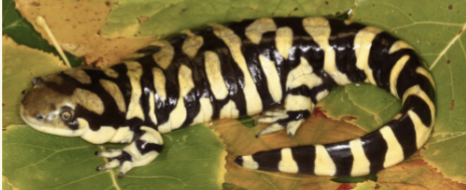

Lithobates pipiens - Northern Leopard Frog
Pointed snout
Distinct dorsolateral folds
Light green halos around brown spots
Tympanum present
Muscular hindlimb
Webbing on hind feet
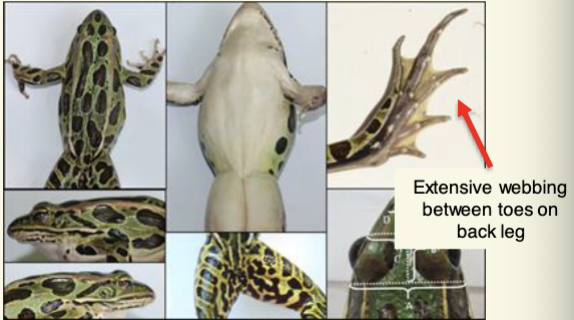

Pseudarcris maculata - Boreal Chorus Frog
Small bodied
Triangular snout, small tympanum
Mask on face that goes from tip of nose to groin
3 broken streaks/stipes down back
Long digits & limbs
Limited webbing
COlor ranges from brown to green
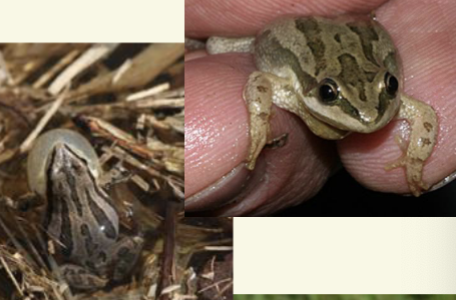
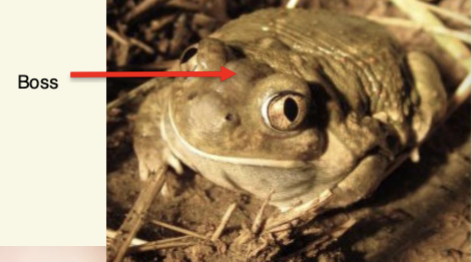
Spea bombifrons - Plains Spadefoot
Smooth skin
Extensive toe webbing on back
Presence of boss
Spade on hind foot
Small tympanum

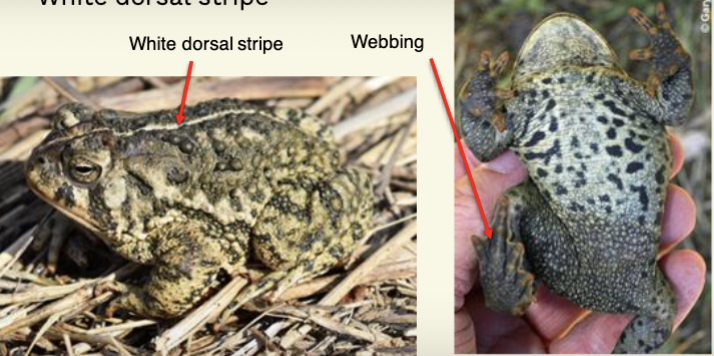
Anaxyrus woodhousii - Woodhouse’s Toad
Rough bumpy skin
Parotoid glands
Extensive webbing
Tympanum present
White dorsal stripe
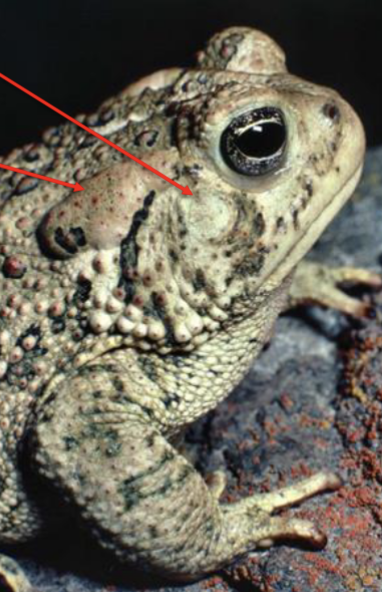
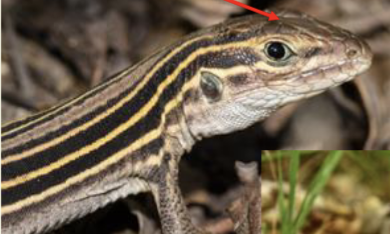
Aspidoscelis sexlineata - Six-lined Racerunner
plate-like scales on head
granular scales on body
visible ears
narrow head
six lines on back
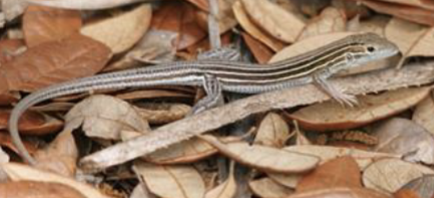
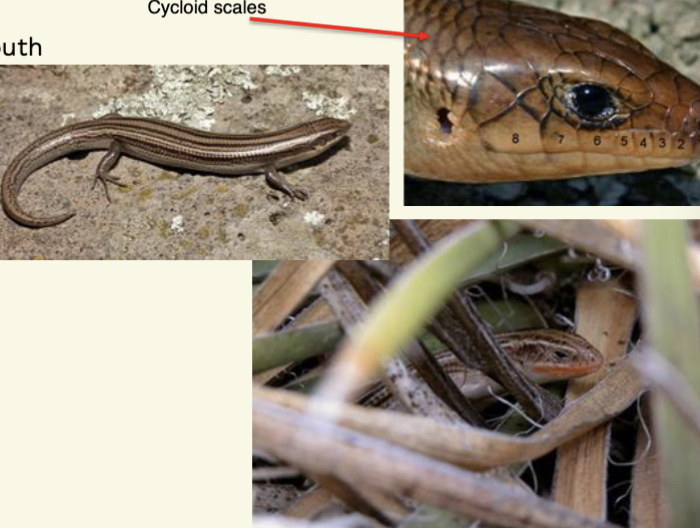
Plastiodon multiviragtus
rectangular head
often have orange color around mouth
ear hole present
thick neck small bodied
cycloid (fish-like) scales
reduced/small limbs
long tail relative to body
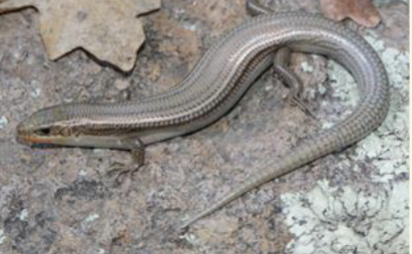
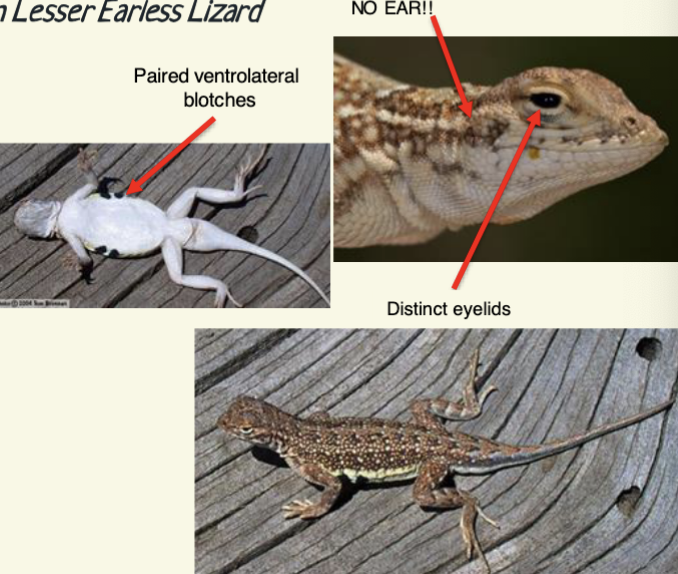
Holbrookia maculata - Common Lesser Earless Lizard
granular scales
rounded head, duck-like mouth
no ear
distinct eyelids
busy pattern on back
paired ventrolateral blotches on each side of belly
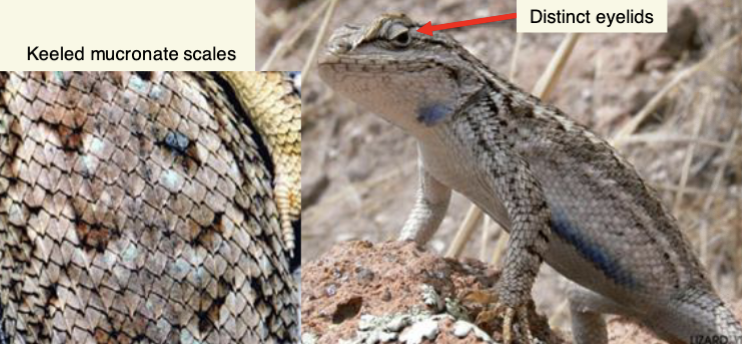
Scaloporus undulatus - Eastern Fence Lizard
distinct eyelids
keeled mucronate scales
pattern on back can vary, often looks like chevrons
blue bow tie often present on ventral side of neck
blue patches on belly
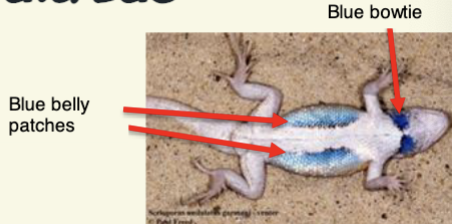

Phrynosoma hernandesi - Greater Short - horned Lizard
Round, flat body
short limbs, short tails
horned scales behind eyes & on back of head
lateral fringe scales
can eject blood from eyes when threatened
pattern & coloration can vary, often with dark patches down back
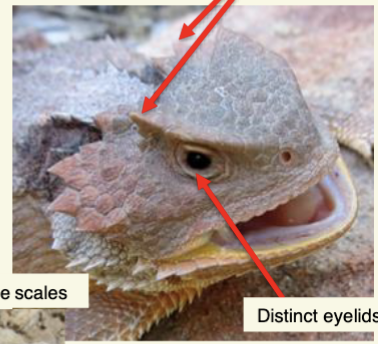

Nerodia Sipendon - Common Water Snake
large head, barred labial scales
messy saddle pattern, slightly off/saddles don’t always connect, generally dark & black
Keeled scales, large-bodied, divided anal scale
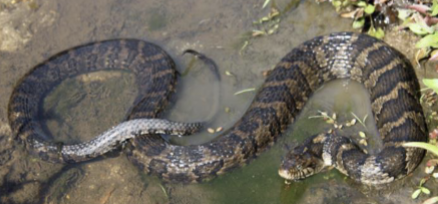
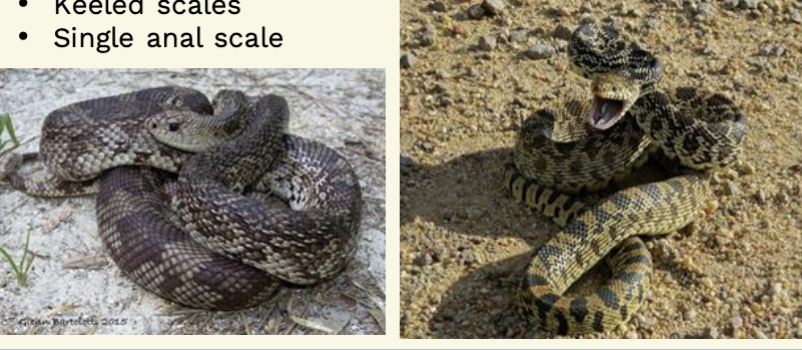
Pituophis catenifer - Gopher snake/Bullsnake
large head, barred labial scales, distinct rostral scale
large head plate scales, often with “unibrow” between eyes
Large body, messy saddle pattern, like desert camo
keeled scales, single anal scale
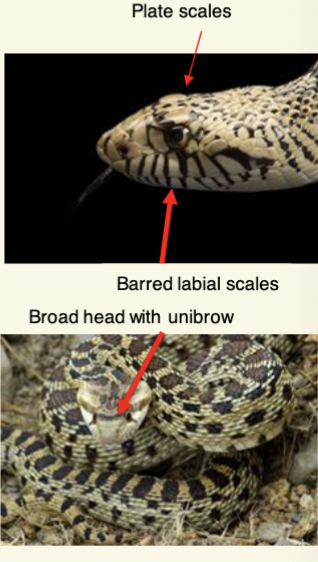
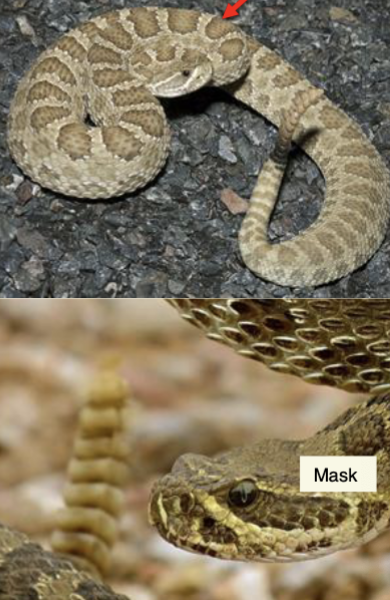
Crotalus viridis - Prairie Rattlesnake
wide head, many small scales on head, white stripes frame mask on face
saddle pattern, short wide body, large rattle
elliptical/slite pupils, single anal scale


Tantilla nigriceps - Plains blackhead snake (Tantilla gracilis specimen)
flat head, round rostrum, large head plate scales
small body, black head, light body, smooth scales, divided anal scale

Lampropeltis trianngulum - Milksnake
Rounded head, banded pattern, large plate scale on head
distinct aposematic color pattern, smooth + glossy scales, single anal scale

Coluber constrictor - North American Racer
angular head, distinct supraocular scale, long tail & body
light colored mandible/jaw, can be black/blue to green
cream or yellow belly with no pattern
smooth scales, divided anal scales
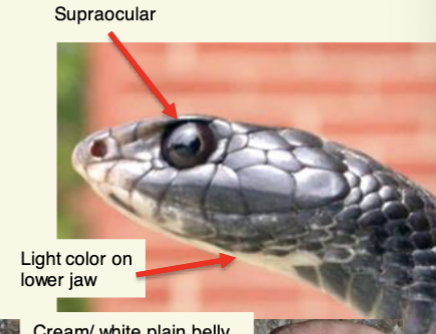
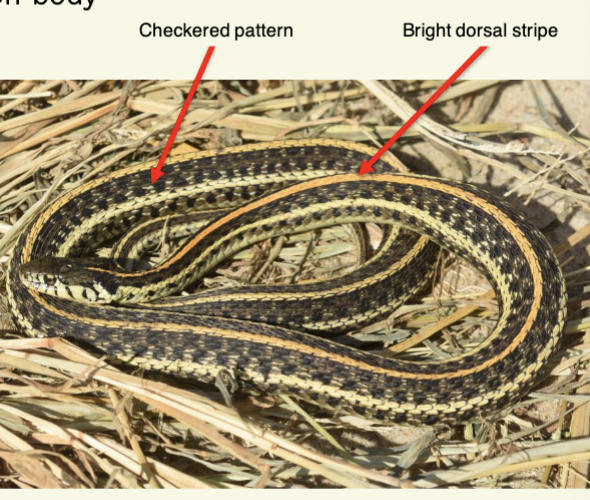
Thamnophis radix - Plains Gartersnake
checkered pattern bw stripes on body
bright dorsal stripe, rectangular head, distinct supraocular scale
blunt rostrum, large eyes, round pupils, barred labial scales
keeled scales, single anal scale
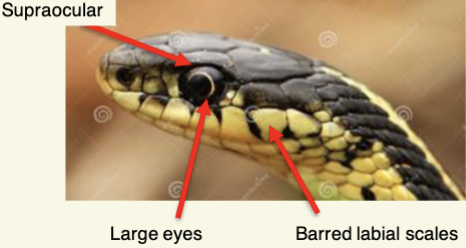
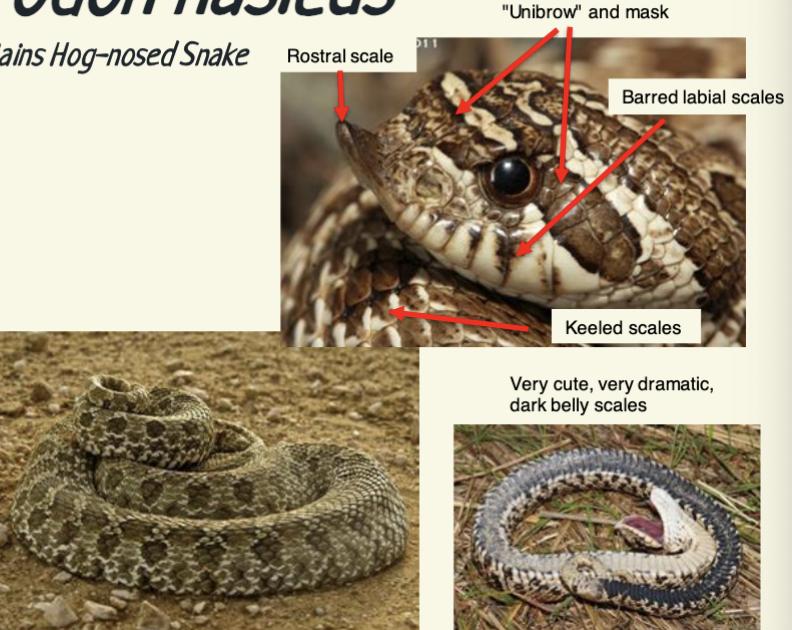
Heterodon nasicus - Plains Hog-nosed snake
blunt & wide head, mask on face with unibrow, barred labial scales
upturned rostral scale, saddle pattern, dark belly scales
keeled scales, divided anal scale
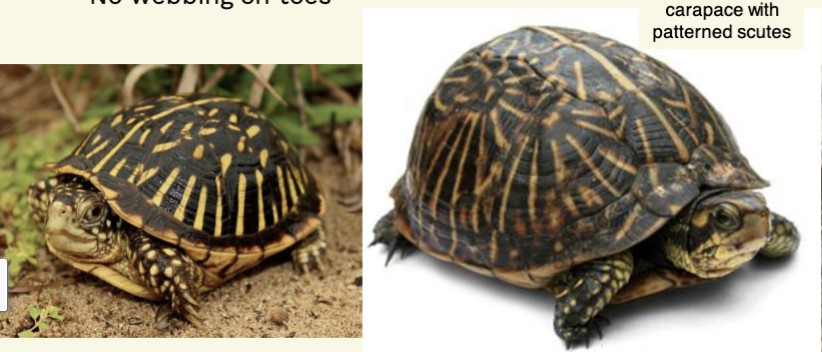
Terrapene ornata - Ornate Box turle
domed carapace
pattern scutes
hinged plastron
females have yellow eyes, males have red eyes
spotted legs, no webbing on toes
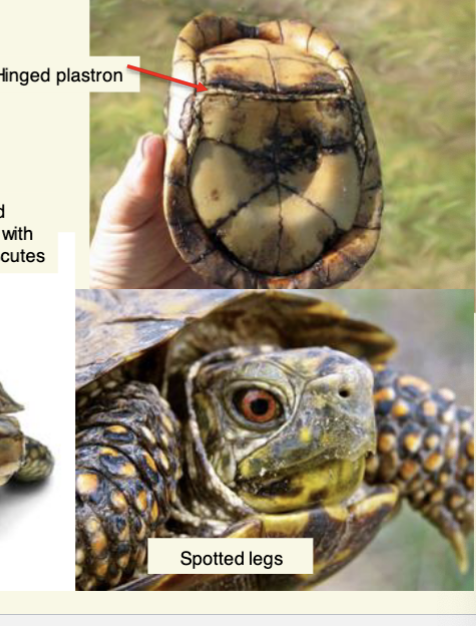
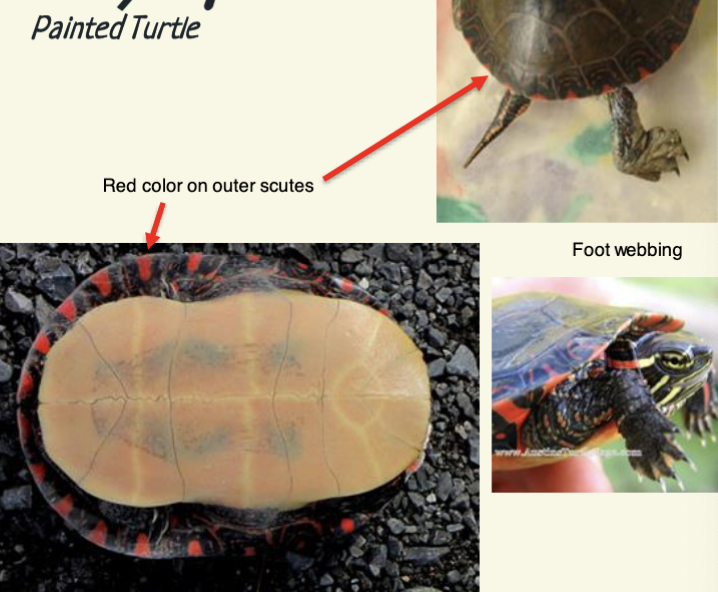
Chrysemys picta
smooth flat carapace
full plastron
extensive foot webbing
yellow streaks on face
red color on outer scutes
small tail
